Before I ever set foot in Budapest, everyone told me I was going to love it. My best friend – whose opinions on travel I tend to hold in high regard – was so enamored with the city. They absolutely fell in love with it and convinced me I would as well.
Suffice it to say, I had high expectations for Hungary’s capital. Though I tried to keep them in check. More than once, I’ve found myself in love with cities others tend to hate, and underwhelmed with ones they love.
Budapest was not one of those cities. It absolutely exceeded my expectations and completely blew me away.
First of all, the architecture is incredible. Before visiting Budapest, I thought Prague had the most beautiful architecture in Europe. Now I think it’s Budapest – or at least it’s a tie. My first day in the city, I couldn’t stop exclaiming how much I loved it and how pretty everything was just about every time I turned a new corner.
I think my travel buddies must have tired of my near-constant gushing, though they never said anything about it.
Then you have the food. Everyone told me I’d love the goulash in Hungary, but what I found really delicious was the chicken paprikash. Hungarian food is just so flavorful. I didn’t realize what depth of flavor paprika could truly have before trying dishes made with Hungarian paprika.
There are layers to this city. Literally. Above the ground you have some of the most mind-blowing architecture. Below the ground, you’ll find the gritty but very cool ruins bars.
Hungary is just such a unique country in Central/Eastern Europe.
After traveling for a few weeks through this region, I was expecting more similarities with its neighbors. But everything from the architecture to the food to the language was different. I’d come to learn Huns from present-day Mongolia originally settled Hungary, resulting in some Asian influence.
I’d encourage anyone who enjoys a good city break and is looking for a unique European city to visit Budapest.
Here are 30+ recommendations for things to do in Budapest.
Climb to the Citadella/Liberty Statue
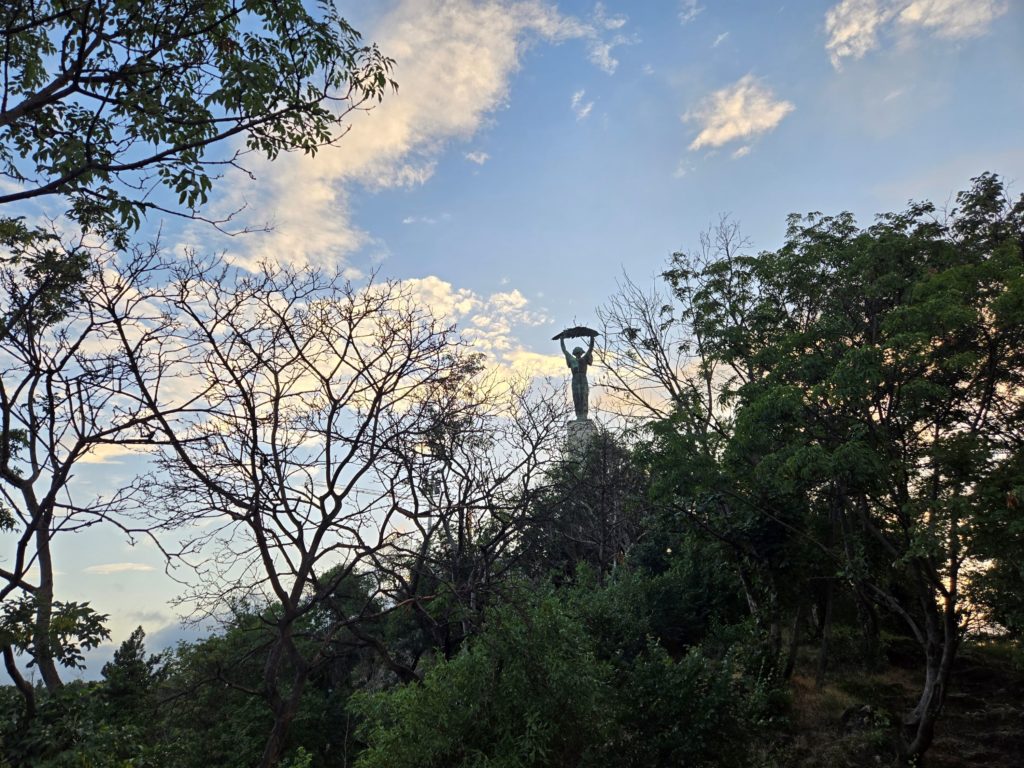
As you’re walking through Budapest, you might notice a large statue looming over the city. A graceful figure of a woman holding a palm frond above her head.
The Liberty Statue is originally from the communist regime for the Soviet soldiers who liberated Hungary from the Germans after WWII. Now, the people of Budapest consider it more of a symbol of driving out invaders throughout history.
On my first day in Budapest, I saw this statue and realized you could climb to it. So that’s exactly what I did. On the Buda side, you’ll see sets of stairs working their way up the hill. Follow them, and you’ll get to the Liberty Statue and the Citadella, with a lot of amazing viewpoints over the city along the way.
There are also maps along the stairs that will show your current location, distance from the statue and where to find the viewpoints along the climb.
When I visited, the statue itself and Citadella area was under construction. Signs said construction is happening after “years of neglect.” But I still got to see the statue up close, and the views were definitely worth it.
Find the Sculpture of Prince Buda and Princess Pest
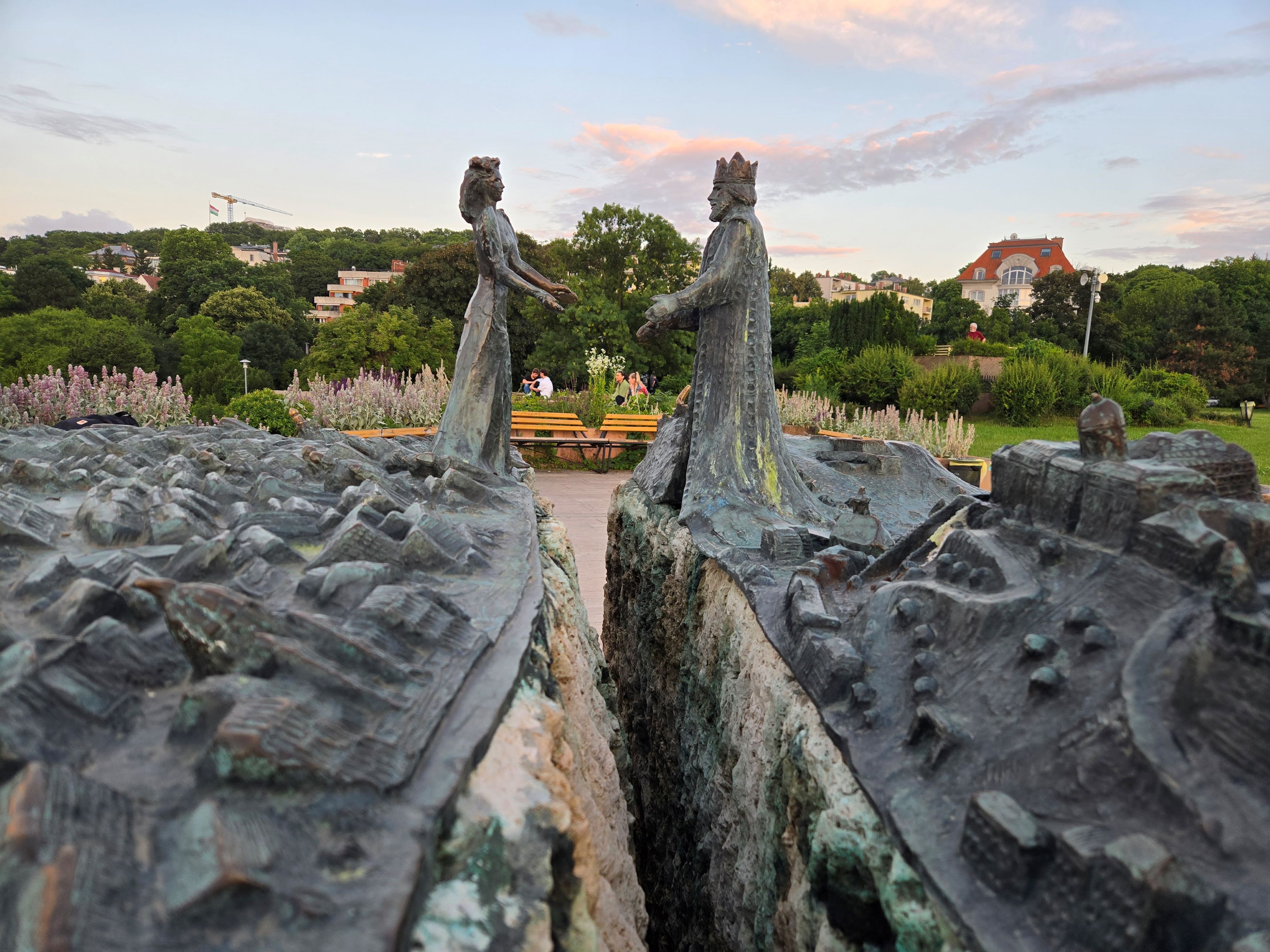
Below the Liberty Statue, situated on Gellert Hill, you can find a sculpture of Prince Buda and Princess Pest. When looking for this statue, I was expecting a life-sized version of the prince and princess. Imagine my surprise when I found something more the size of the large dolls!
This sculpture depicts a tragic story of two lovers divided by the Danube. It shows them reaching out to each other across the river, symbolizing the unification of the Buda and Pest sides of Budapest.
The real beauty in the statue is its placement in Philosopher’s Park on Gellert Hill. It’s especially beautiful in the summertime, surrounded by wildflowers. On some nights, there is dancing in the park near the statue.
Walk across the Széchenyi Chain Bridge
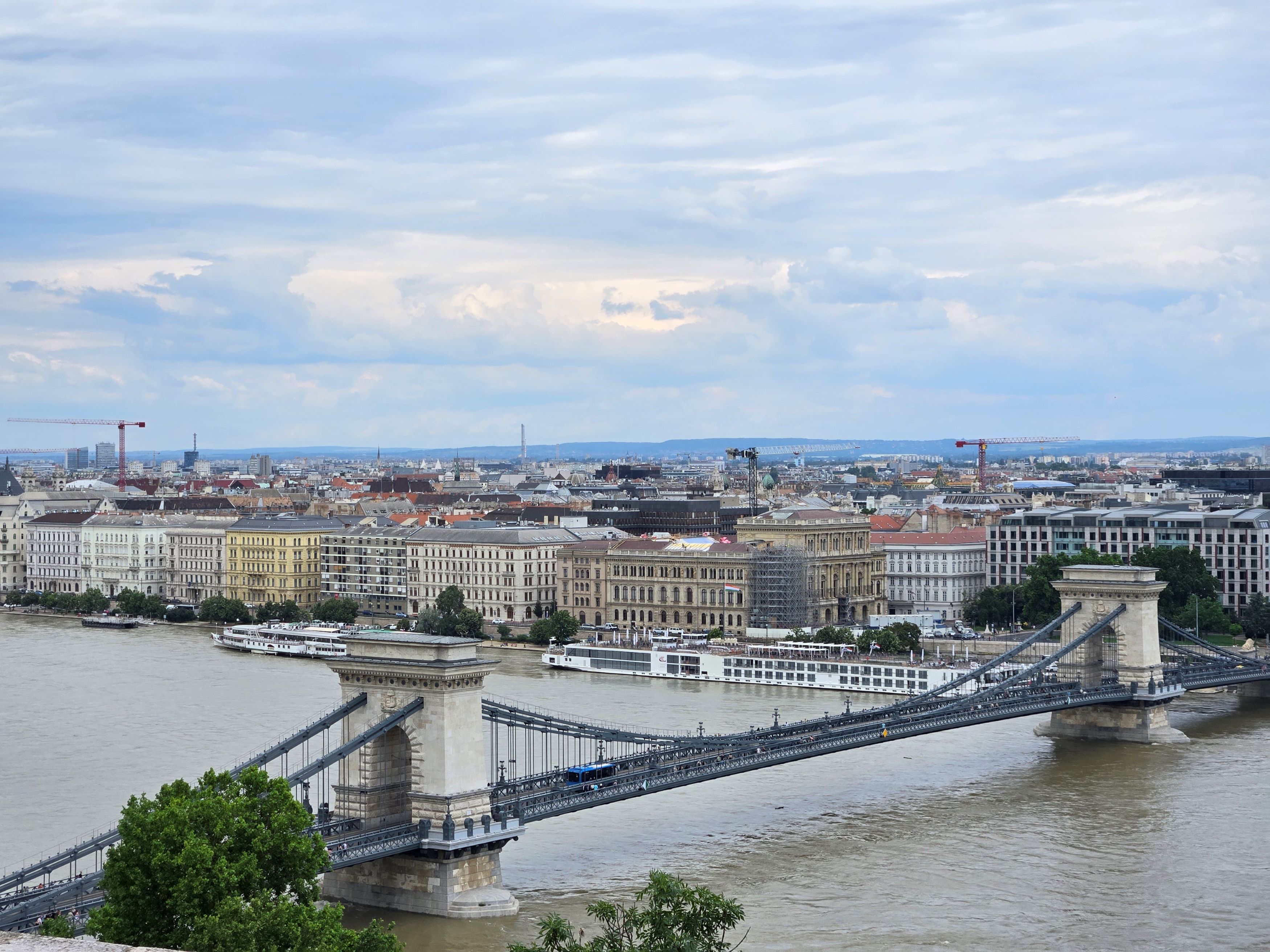
Perhaps the most popular bridge across the Danube in Budapest, the Széchenyi Chain Bridge was also the first permanent bridge connecting the two sides of the city. It stretches from Széchenyi Square on the Pest side to Adam Clark Square near Castle Hill on the Buda side.
Originally built in 1849, this bridge was one of many that was destroyed in WWII bombings and rebuilt. It still retains its impressive scale and architecture, and is one of the largest bridges in the world.
As you walk across the bridge, you’ll marvel at the iconic stone lions greeting you as you enter. The chain link designs stretching the length of the bridge are also really neat to see up close.
While Budapest has great public transportation connecting each side of the city, I recommend making sure at least one of your trips between Buda and Pest involves walking across this bridge.
Explore Buda Castle Area
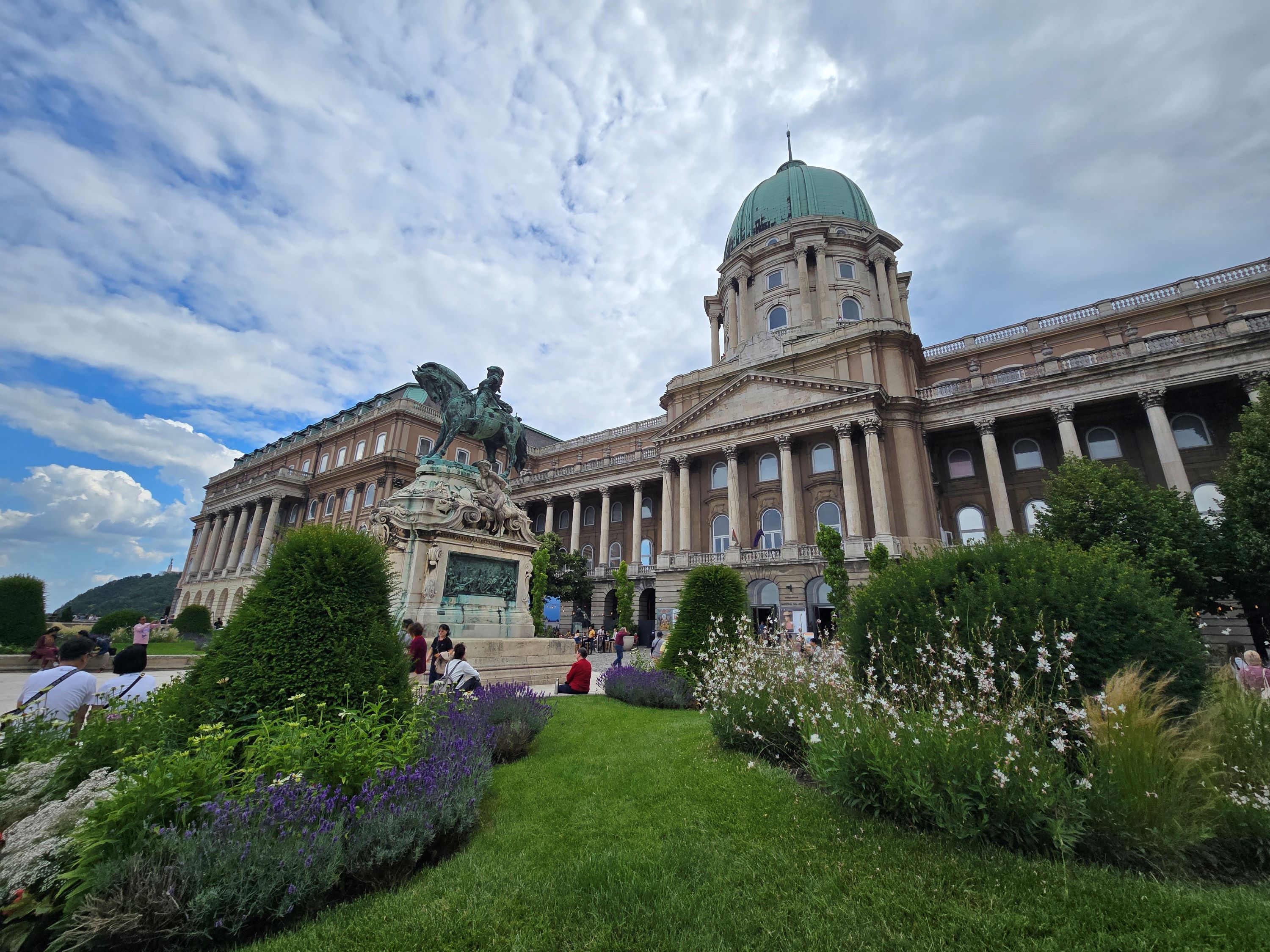
Buda Castle and Palace Complex towers above Budapest on a high hill on the Buda side of the city. Visible even from the Pest side, you can’t miss seeing it from multiple points in the city. It is sprawling.
Buda Castle was originally completed in the 13th century, but the large palace complex was primarily built in the 18th century. Hungarian kings lived there for centuries. The castle is now home to the Hungarian National Gallery and the Budapest Historical Museum.
A visit to this complex on Castle Hill really is a must-do thing in Budapest. Most of the complex is free to explore. You don’t have to pay anything to admire the medieval baroque architecture and the stunning views of the city. However, visiting the museums and Fisherman’s Bastion will cost money.
Admire Matthias Church
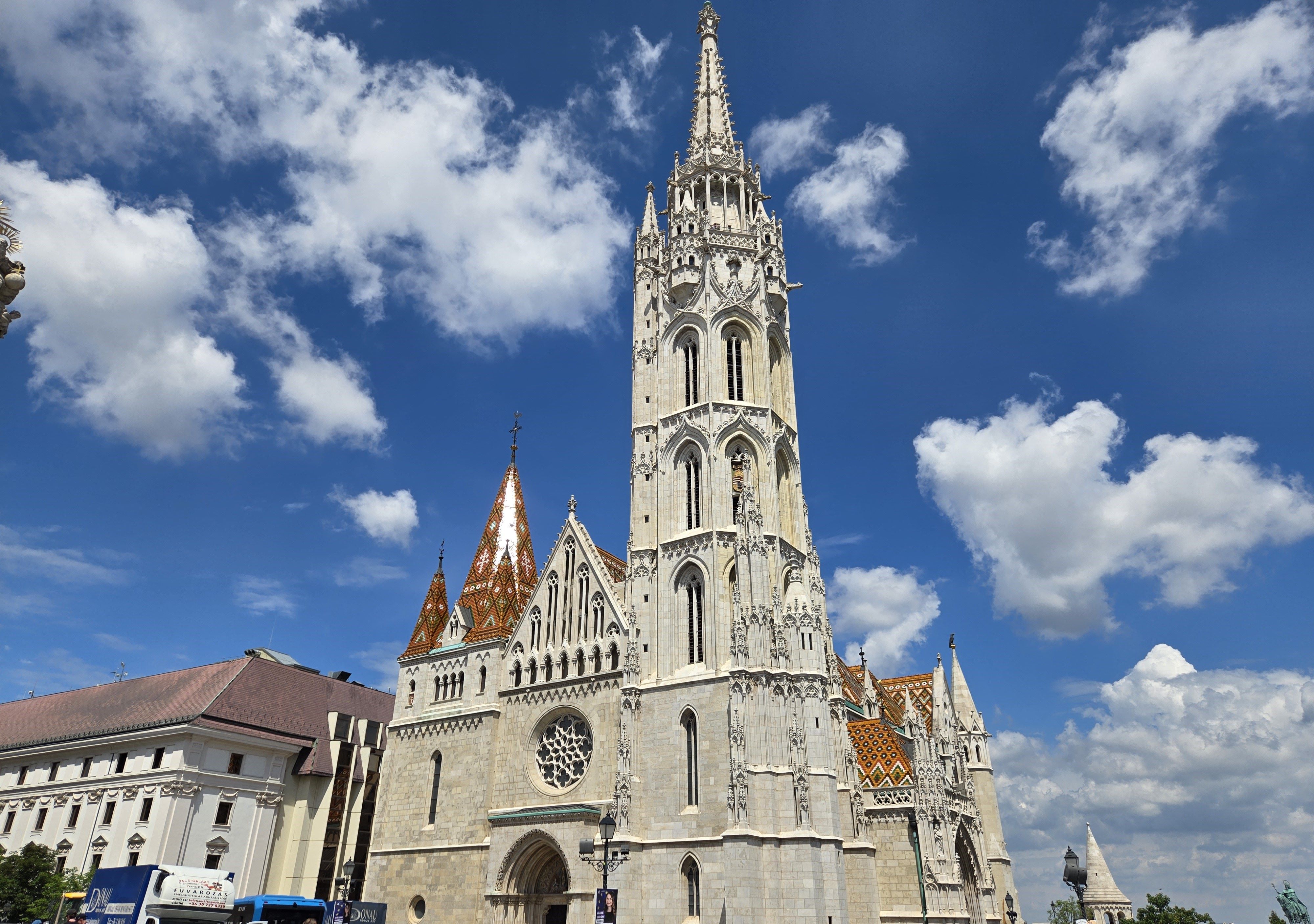
Matthias Church – also known as The Church of Our Lady of Buda Castle – is considered one of the most unique medieval churches in the world. It sits at the top of Castle Hill on the Buda side and has a storied history.
Founded in 1015, the church was the site of several Hungarian kings’ coronations for centuries. During the Ottoman occupation of Hungary, it functioned as a mosque but is now a church again.
Aside from its history, what makes it truly unique is its beauty. Though I didn’t pay the high fee to see inside the church, it is absolutely stunning from the outside. The church boasts the classic ornate gothic architecture, but is really set apart by its colorful tiled roof. I could not stop staring at the many colors of the rooftop, contrasted with the white building in the sunlight. Truly a sight to behold.
As the church is on top of the hill, this area is also a great place to enjoy more sweeping views of Budapest. That is, once you can peel your eyes away from the church.
Go to the Top of Buda Tower
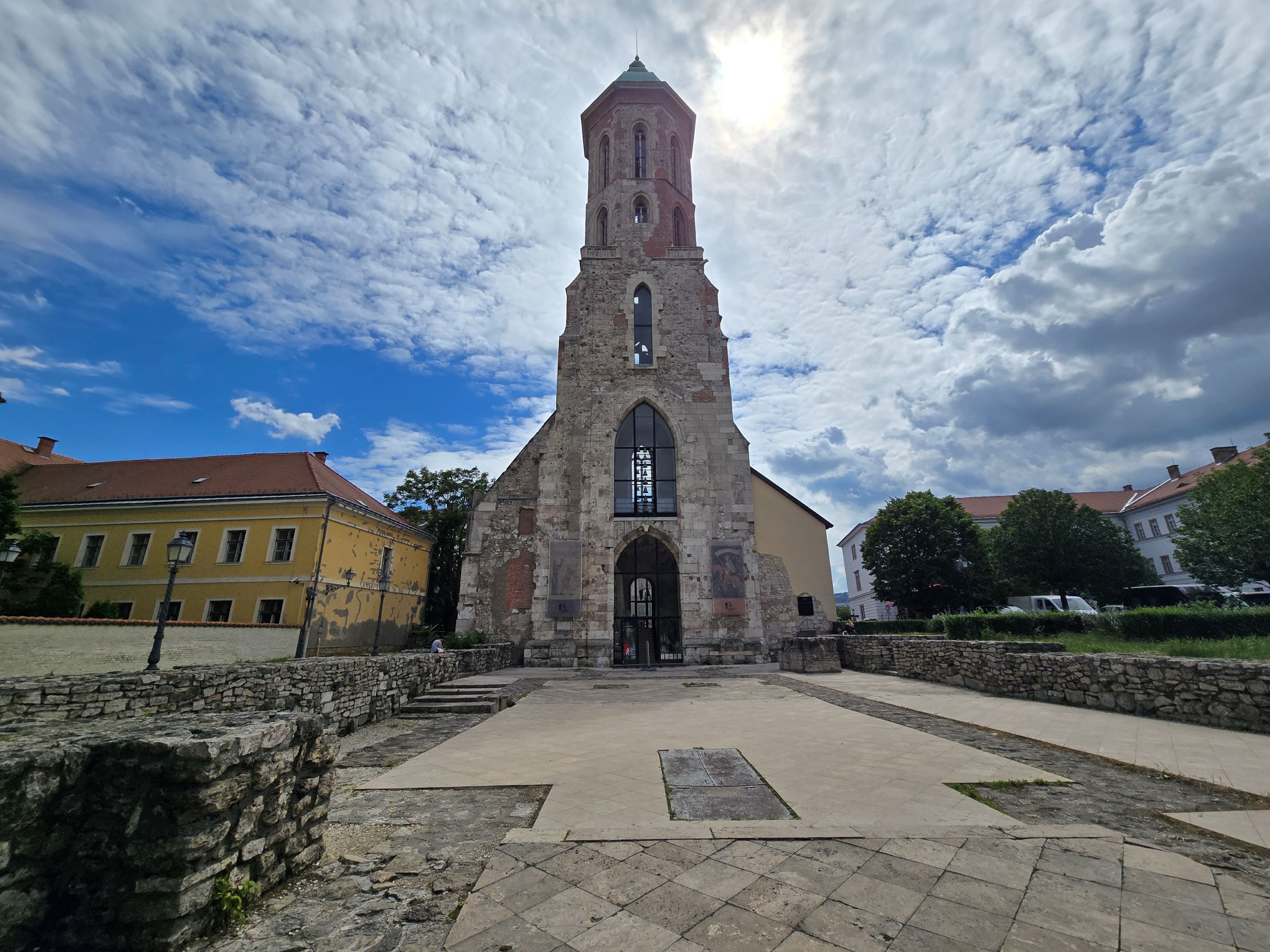
Buda Tower, also known as Magdalene Tower, is another gem in the Castle District. Built in the 13th century, this tower survived 600 years of sieges before being badly damaged in WWII. It was closed to the public for several years before its restoration.
It was just under €4 to go to the top of the tower, which I felt was a fair price. I climbed the 172 stairs up the narrow spiral staircase to the top and enjoyed panoramic views of the Castle District. It was worth it for the experience and the views – especially seeing the ornate rooftops from above.
Take a Free Walking Tour
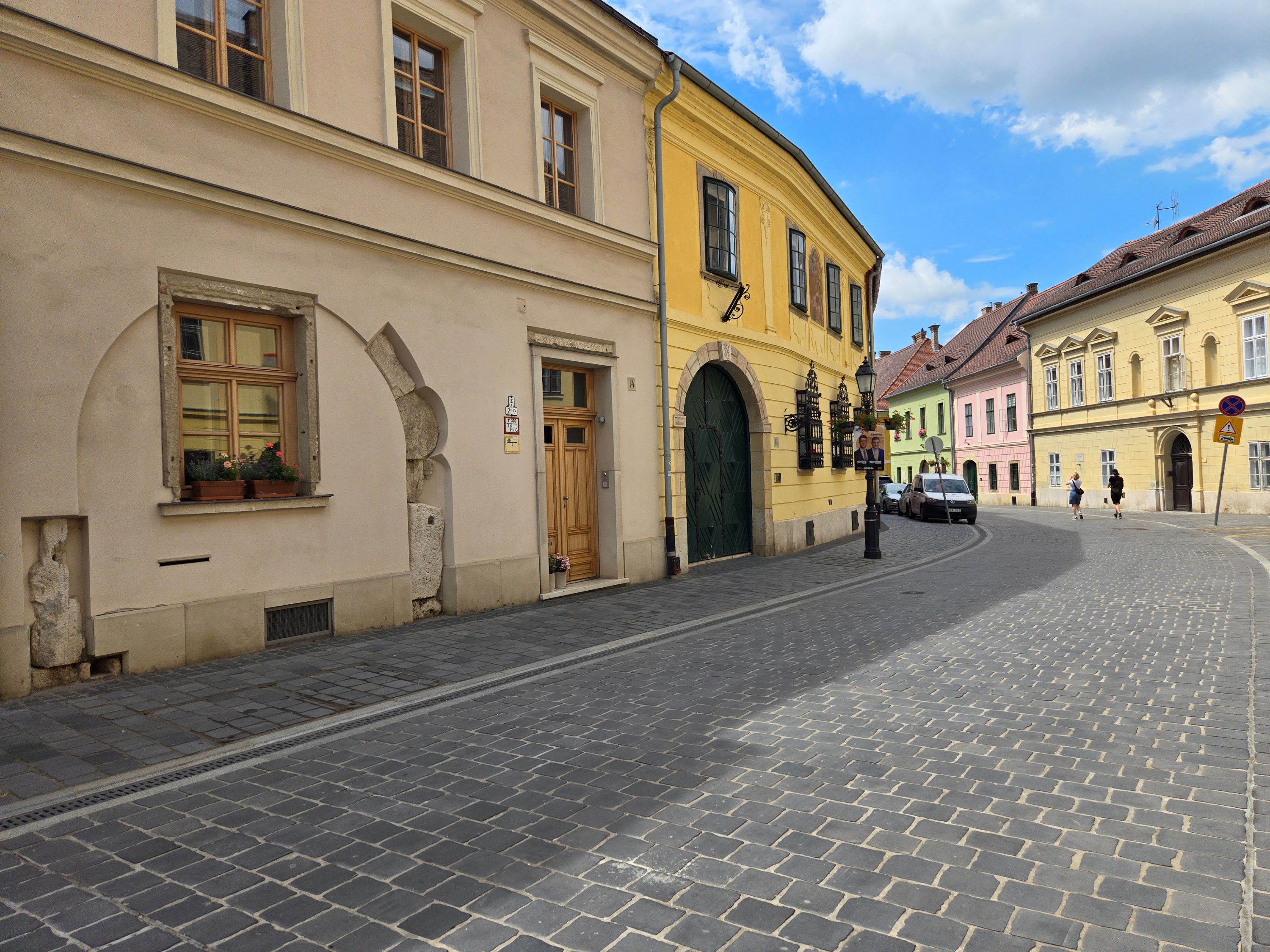
One of my favorite things to do in a new city is look for interesting free walking tours, and Budapest was no different. Free walking tours can help orient you in a new city, share deeper insight into its history and culture and give you ideas for additional things to do. I recommend taking a walking tour on one of your first days in a city for these reasons.
Because I’m traveling long-term right now, I prefer to take more niche/themed tours rather than the more standard city tours (though those are usually also very helpful). I suspected Budapest would have some interesting tours from which to choose.
I chose a tour called “Secrets and Highlights of Budapest.” This tour showed us around some of the popular sites in the city while also showing some of the less known things in Budapest on the Pest side. Our guide Robert made it extra fun by offering prizes (candy) for answering trivia questions throughout the tour – something I’ve never seen on another walking tour. He also sent a huge list of recommendations for places to see, eat and shop afterwards.
If this tour doesn’t interest you, there are plenty of other options. Some explore the Buda side, some the Pest, and some both.
Learn the Truth Behind Liberty Square
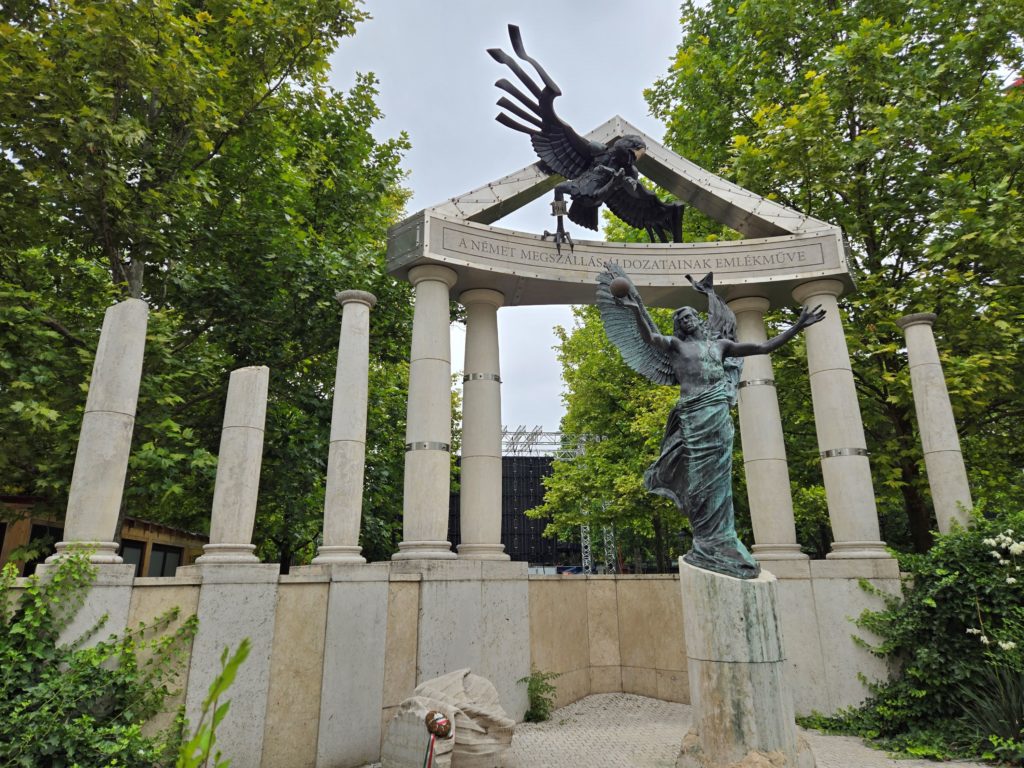
Liberty Square is a very interesting area in Hungary. It’s home to the US Embassy and the old Hungarian National Bank. It features a monument to Ronald Reagan and a statue of George H.W. Bush.
However, the most controversial thing about Liberty Square is the Liberation Monument, the namesake of the square. The monument is about the German occupation in Hungary near the end of WWII. It features an eagle (symbolizing Germany) attacking an angel (symbolizing Hungary).
The reason this monument is so controversial is because some Hungarians consider it sort of revisionist history. Hungary supported Germany in WWII up until 1944. Some people say this statue implies that Hungary was an unwilling part of the war for its entirety, while it was a German ally for most of the war.
When the government announced the plans for this statue, there were protests in the square. So many people were against it that it was erected in the dead of night. They placed barbed wire around it to avoid vandalism.
In protest, Hungarian people put up laminated papers telling the history of Hungary’s role in WWII, along with portraits of Jewish Hungarian victims of the Holocaust. It has turned into a sort of small Holocaust memorial, with people placing white stones under the photographs per Jewish tradition.
Find the Miniature Statues
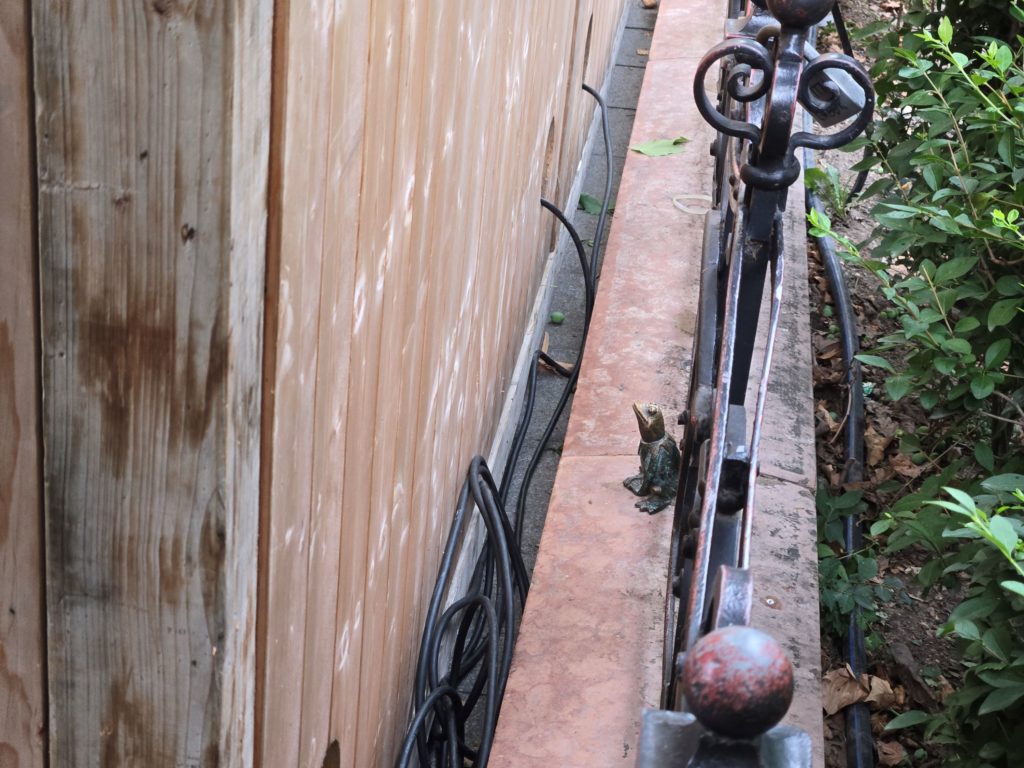
One of the quirky things to do in Budapest is to go on a hunt for mini statues! There are over a dozen throughout the city. Hunting for all of them would keep you occupied for hours, but finding a couple of them is possibly just as fun.
The sculptures are the work of a Ukrainian-Hungarian guerilla sculptor, Mihály Kolodko. Over the years, he’s sneakily placed these sculptures all around. They don’t seem to have one obvious cohesive theme. You can find a Kermit-esque frog, a tank and a dead squirrel, for example. Like most good art, it’s up to your interpretation!
See the Soviet War Memorial
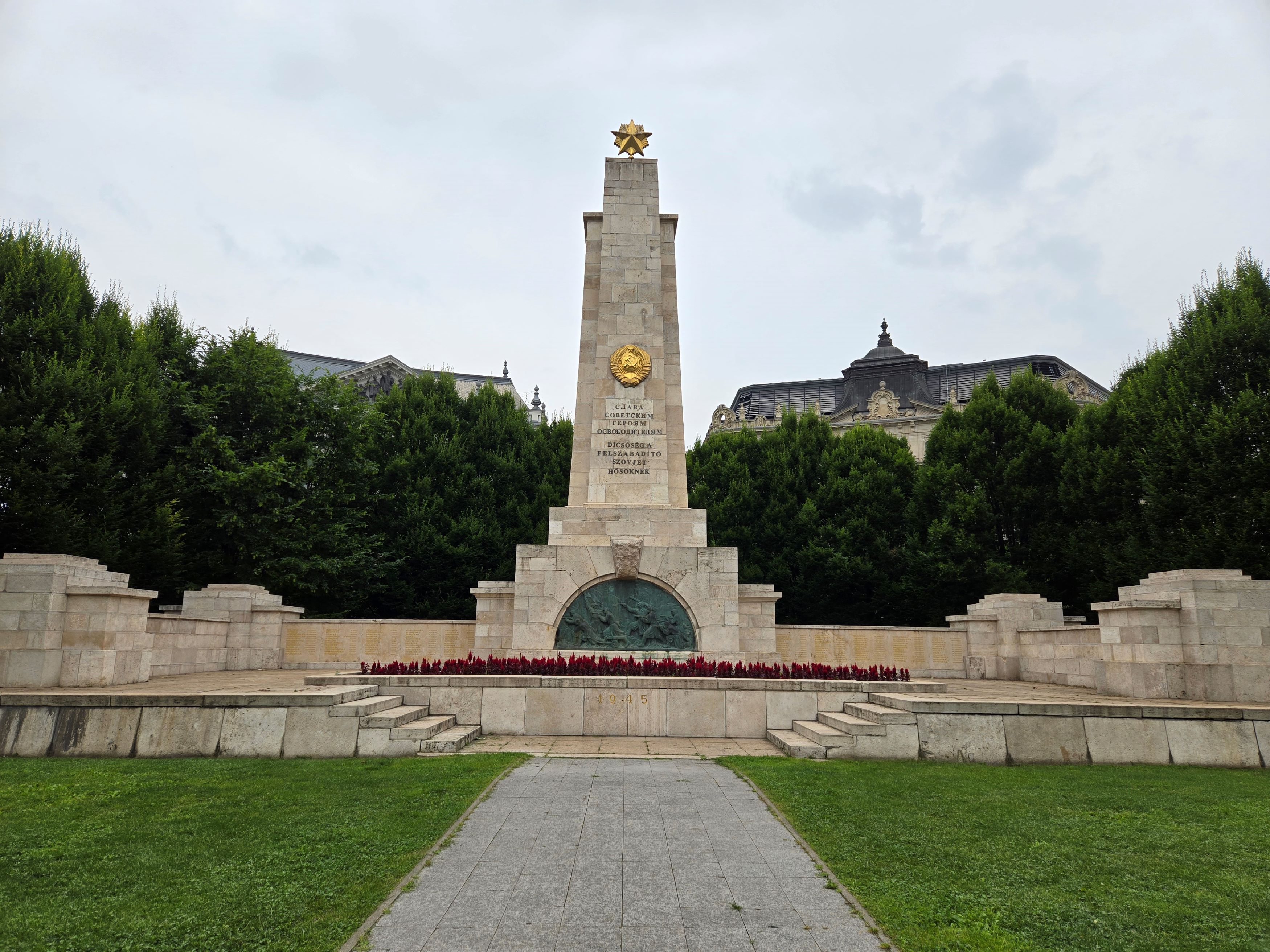
Another controversial monument in Budapest is the Soviet War Memorial. This monument, surrounded by red flowers of course, is dedicated to the Soviet soldiers who died freeing Hungary from German occupation at the end of WWII. It is similar to the Slavin Monument in Bratislava.
There have been talks of removing the monument every now and then given that the Soviets then occupied Hungary for decades following WWII. However, the memorial also serves as a grave for these soldiers, so many people feel it would be wrong to remove it.
Visit the Hospital in the Rock Museum
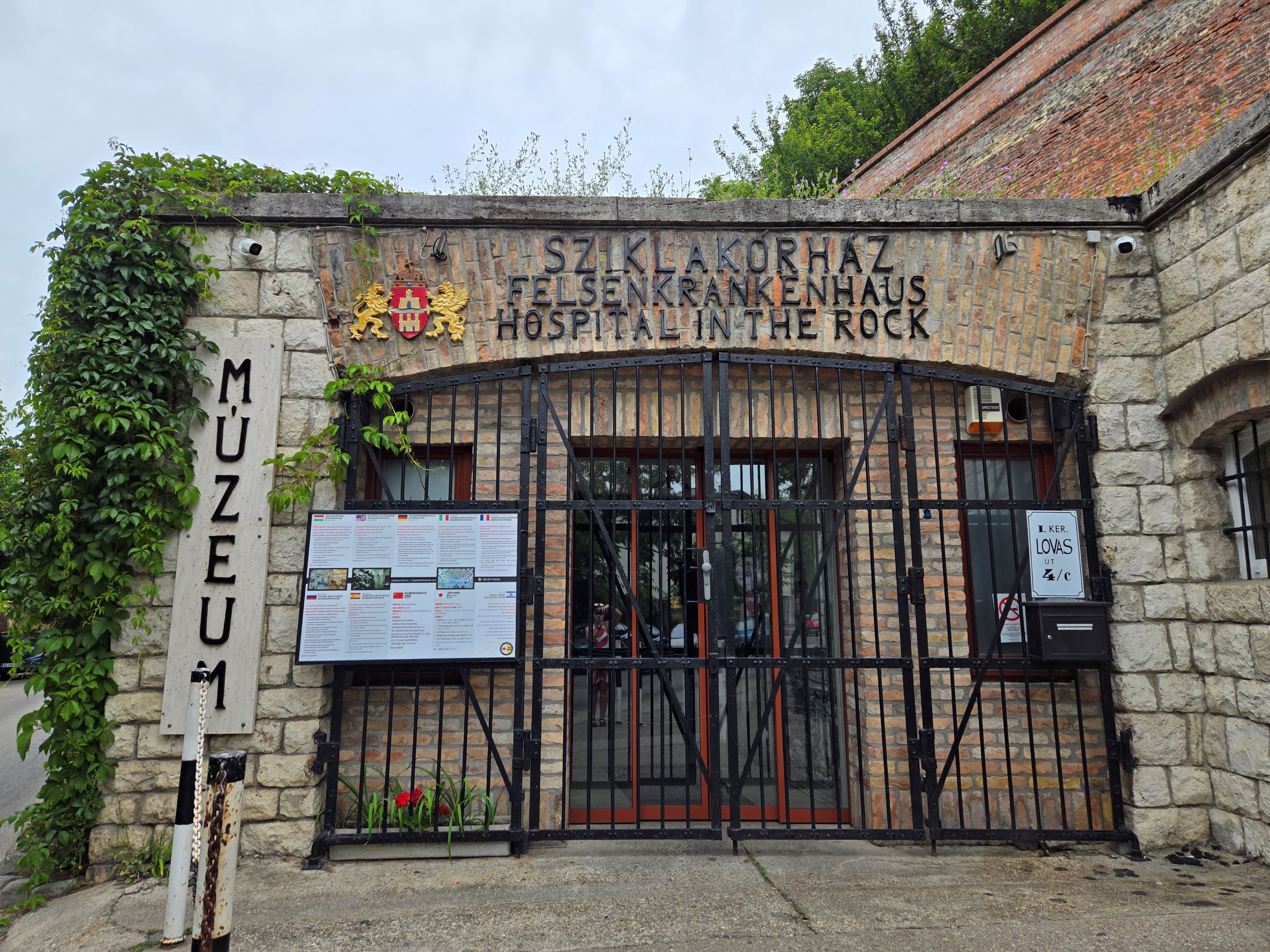
The Hospital in the Rock Museum is another interesting piece of WWII history in Hungary. It also offers a glimpse into Budapest’s extensive underground cave system.
At the start of WWII, people discovered some useful caves in Budapest. One cave became a hospital and bomb shelter. The Red Cross operated the hospital, so everyone had to be treated there, regardless of affiliation. In 2008, it was turned into a museum.
The Hospital in the Rock museum allows visitors to explore this cave on a one-hour guided tour. During the tour, you’ll see hospital scenes recreated with wax figures using the original 1950s-era equipment. You’ll also see medical equipment from this era on display in glass cabinets. The old amputation knife was so small. I couldn’t believe it cut off limbs.
The second part of the tour teaches more about the history of WWII and Hungary’s eventual resistance against Germany. Then, you visit the bomb shelter. You can see the area where they stored water tanks and other supplies. The guide said the shelter was intended to be first come, first serve – as in no special treatment for certain people seeking shelter. Luckily, no one ever had to find out if that was true.
I also learned on this tour that the Soviets built the metro stations, and they could double as bomb shelters. That’s why they’re so deep. But it didn’t explain why the escalators are so fast.
The final part of the tour is a memorial to the victims of Hiroshima and Nagasaki. It details the experience and aftermath of the nuclear bombings through stories and pictures drawn by a Japanese artist. It ends on a note hoping nothing like it will happen again.
Explore the Caves Underneath Buda Hill
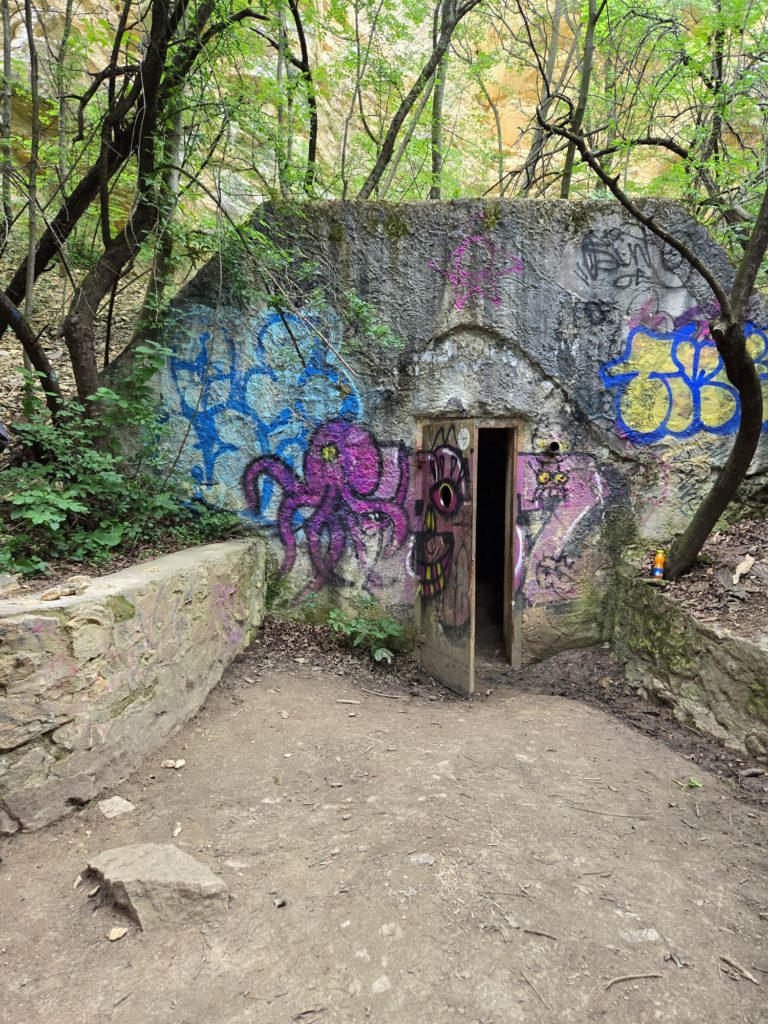
Tons of visitors to Budapest like to climb to the top of Buda Hill and hike above the city. I enjoyed this part of my visit as well, but another thing to do in Budapest is actually to go underneath the hills.
As I mentioned above, Budapest has an extensive cave system. You can visit them by taking a tour of the Labyrinth under Buda Castle or the Hospital in the Rock Museum. Or you can actually go caving!
Pal-volgyi Cave is the longest cave underneath Budapest and on the list of tentative UNESCO World Heritage sites. I booked with Airbnb Experiences to explore the cave, but you can find the same experience through Get Your Guide, Viator or even locally through some hostels and hotels.
Arriving at the cave, the guide gave us all jumpsuits and hardheads with headlamps, and we set out to explore Budapest’s longest cave. The guide has been leading tours of this cave for over a decade and tailored the path to the capabilities of our group. We went through some tight squeezes, but everything was doable. Here, we learned the history of the caves and saw interesting natural formations and fossils from when it was a seabed. It was a very unique experience.
Admire the Parliament Building
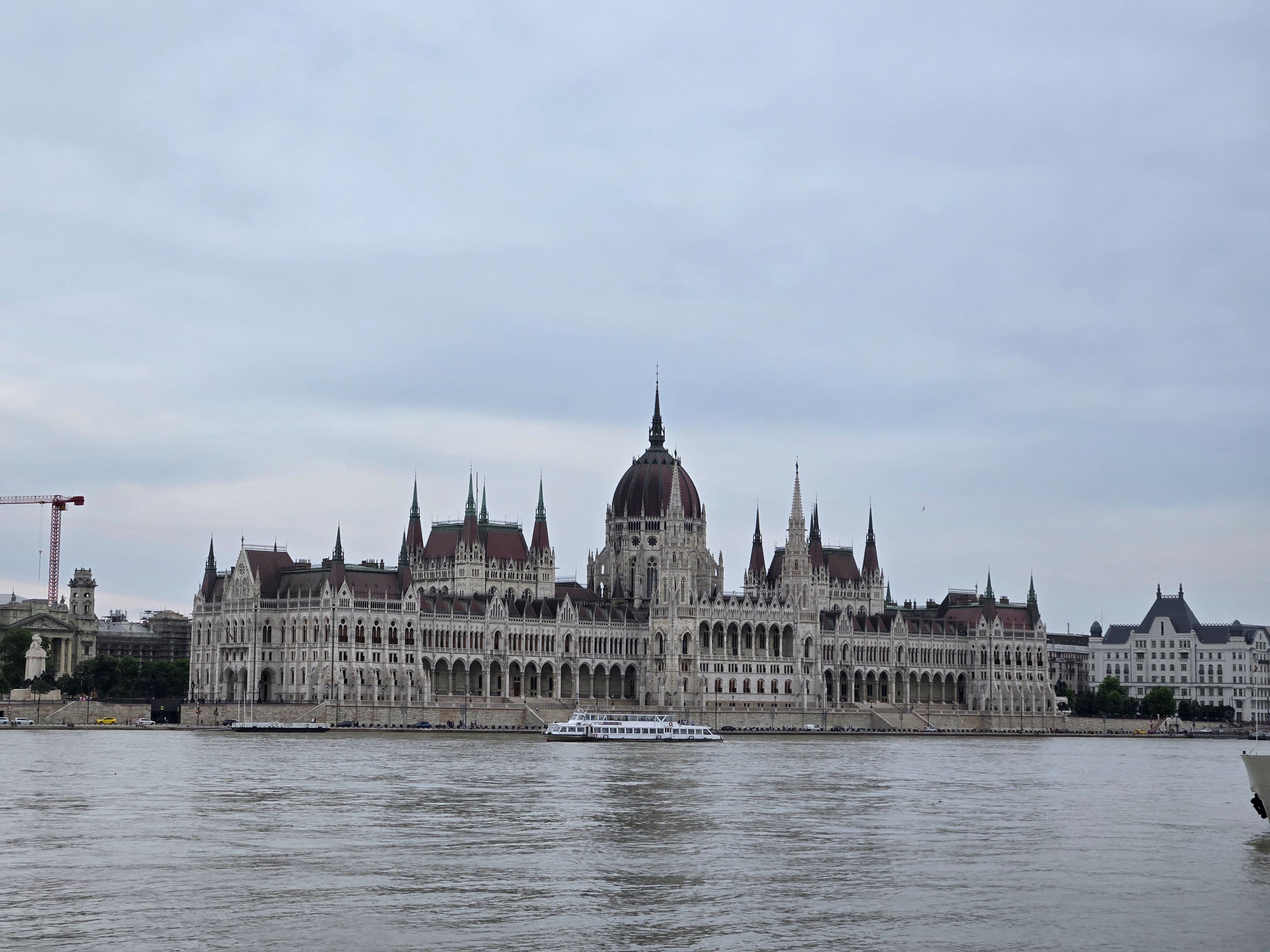
Budapest’s architecture, especially along the banks of the Danube River is absolutely stunning. But believe me when I saw the Parliament Building is the crown jewel.
The Parliament Building sits on the Pest side of the city and is one of Budapest’s most iconic landmarks. Its neo-gothic design was influenced by Vienna’s City Hall, and it is the largest building in Hungary.
The Parliament Building marks an important occasion in Hungary’s history as it was created as an expression of the country’s sovereignty. As a country that has been occupied for much of its history, sovereignty is extremely important to Hungarian people.
I visited the Parliament Building from the outside on my walking tour, but you can also take a tour of it inside if you want to see its interior.
Stroll Along the Danube
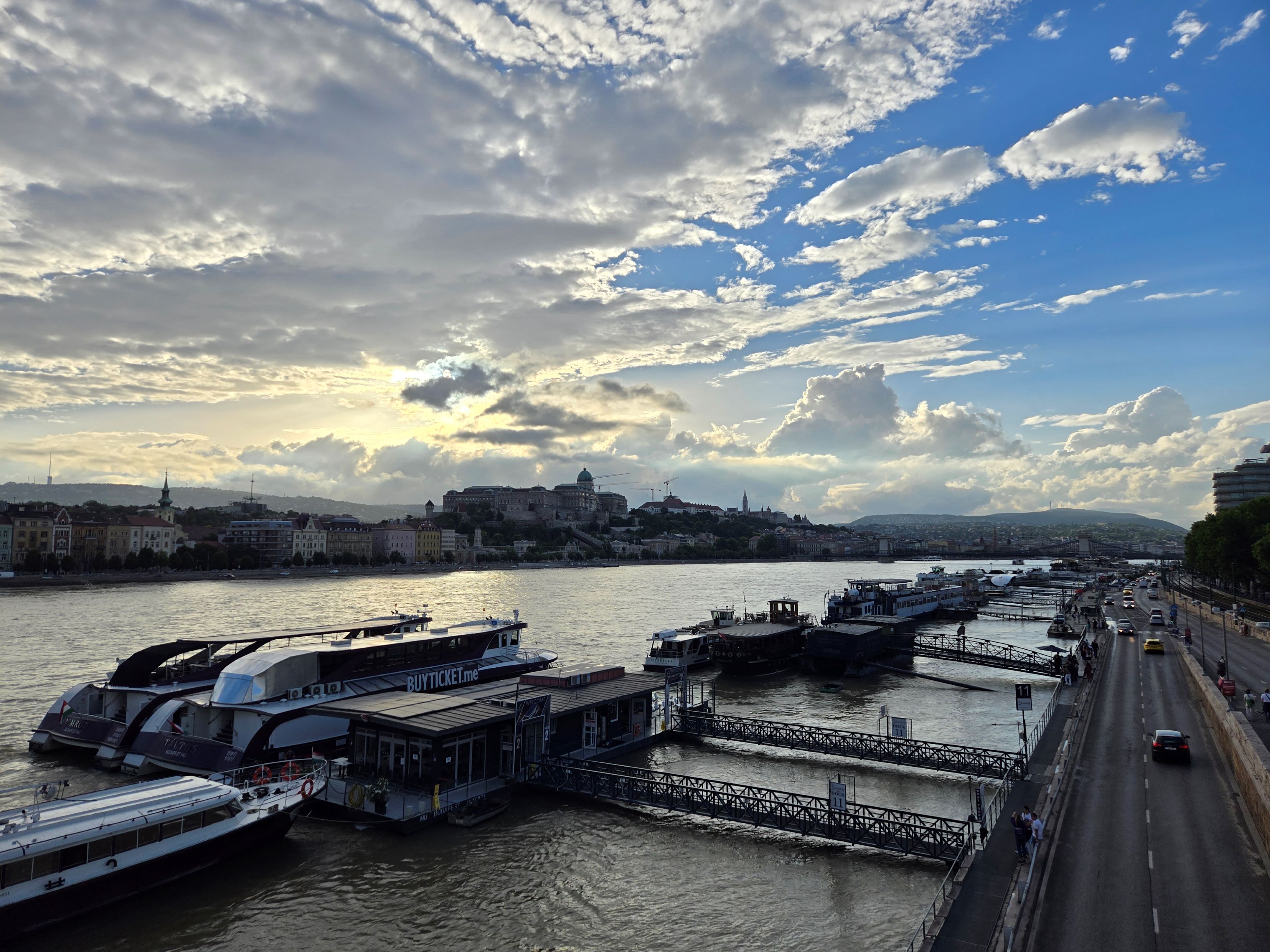
Hungary is one of the 10 Central/Eastern European countries through which the Danube flows. Budapest is a typical stop on a multi-day Danube River cruise. It’s one of the most important rivers in this part of Europe, and it is a significant part of Budapest’s makeup.
There are lengthy river walks along the banks of the Danube on both the Buda and Pest side. I recommend taking walks on each side to see the different perspectives. You can stroll along one side to one of the many bridges connecting each side of the city and then cross it for the other.
Take time to admire everything. The rushing Danube, the many boats cruising the river and the quirky statues along the banks. You can even stop for a coffee or cocktail at one of the many riverside bars or cafes. However, I wouldn’t recommend getting a meal at any of these restaurants as all the food had low reviews.
Relax at the Thermal Baths
Visiting a thermal bath is one of the quintessential things to do in Budapest. Let me tell you why. Budapest sits on a geographical fault line where the hills meet the Great Plains region. The result is several sites where mineral-rich thermal water flows into hot springs, creating these thermal bath areas.
The most famous thermal bath in Budapest is the Széchenyi Bath. You’ll hear locals saying this is the tourist bath, not the local bath. I’d heard it was overcrowded and a bit run-down. But there are so many thermal baths in Budapest, you could visit a different one every day of your visit.
I opted to visit Rudas Bath. They have an option for night bathing between 10 p.m. and 2 a.m. on weekends, and a rooftop thermal bath with a panoramic view of the city. I went around 10:30 after an evening Danube River Cruise and really enjoyed it! I took my time visiting the uncrowded lower baths of varying temperatures, then made my way to the rooftop pool. This part was obviously more crowded, but the view of the city at night was worth it.
I encourage you to find the bath that fits you! I read Gellert was the fanciest, for example. Before going to a bath, make sure to check you’re visiting on a day you can actually enter. Some baths only allow certain genders on certain days/times.
Make sure to bring your bathing suit, waterproof shoes and not too many valuables. And remove any jewelry before because the minerals can impact them.
Take a Danube River Cruise

Before visiting, I heard taking a Danube River Cruise was a top thing to do in Budapest – especially at night. And the night cruise definitely did not disappoint.
One of the most striking things about Budapest is the incredible architecture along its waterfront. And the best way to experience it is from a boat. Sure, you can see it from the banks of Danube or from the Buda Hills up above. But there is nothing like leisurely cruising down the water and seeing these architectural delights from a closer vantage point.
While I didn’t do a daytime cruise, I felt a night cruise was absolutely perfect. Especially because the timing worked out that I boarded the cruise just as the sun was starting to set. So I got to watch the sunset from the cruise and enjoy views in the fading daylight. Then, I got to watch the city light up at night. The Parliament Building looks especially magical like this at night.
If you choose to take a Danube Cruise, I assume you really can’t go wrong with any company. Most offer a welcome drink, but some also offer unlimited drinks or prosecco. I opted for an unlimited prosecco cruise because I was taking the cruise for my birthday. Though I was tempted by a cruise I saw that took place on a replica of a Hungarian steamer paddleboat.
Note that the night cruises are the most popular, so will cost a little more. Make sure to show up early so you can get in line to board the boat. The earlier you board, the better chance you’ll have of getting a good seat.
Explore Margaret Island
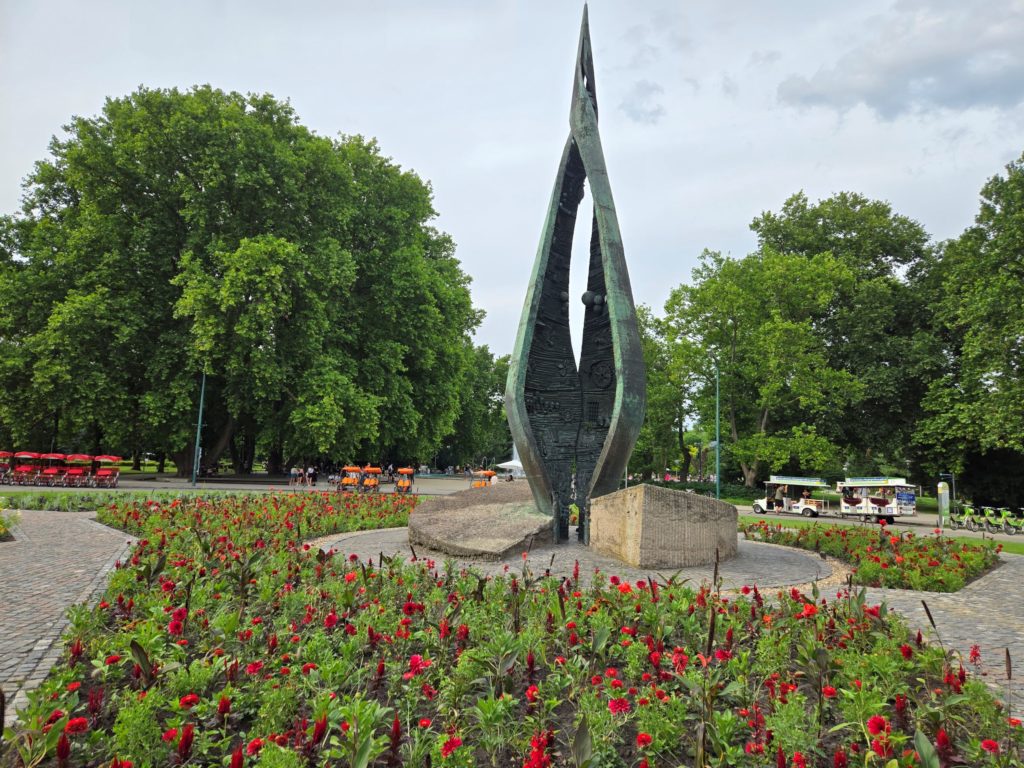
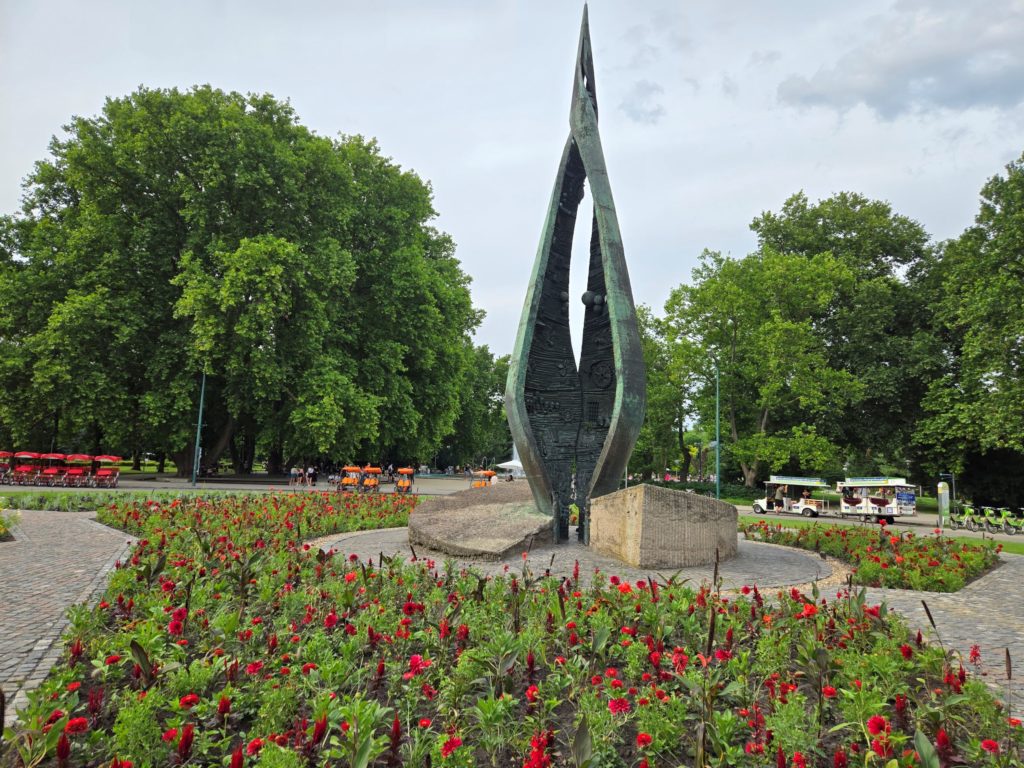
Margaret Island a mostly-pedestrian island in the middle of the Danube. Cars are not allowed on the island except to drop people off at its entrance near the bridge. You can, however, ride bikes or golf carts on the island.
On the island, you can find gardens and see some wildlife if you’re lucky. I’d heard about some people even spotting otters! The island also hosts a musical fountain that plays music with a light and music show for about 15 minutes at the top of the hour. Make sure to get a seat to enjoy it.
Shop or Snack at the Great Market Hall
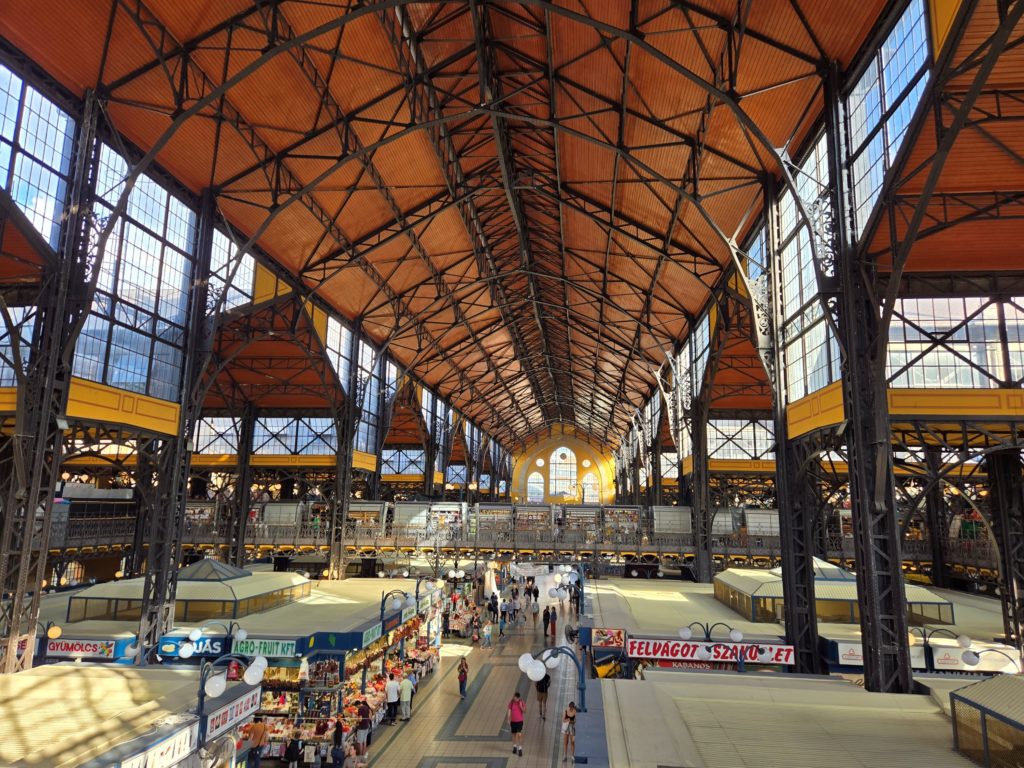
Built in 1897, the historic Great Market Hall is the largest market in Budapest. It is also quite beautiful. The Great Market Hall holds three floors of all kinds of goods – mainly foods, drinks and souvenirs.
You can find traditional Hungarian foods like langos and drinks like Tokaj. You can also find local produce, jams and spices. This market is a great place to look if you want to take home some traditional Hungarian paprika, for example. If you do choose to eat here, however, be aware that it caters to tourists, so you might not be getting the best meal in town. I opted to grab a couple of pastries for a bit of breakfast and eat a real meal elsewhere the morning I visited the Great Market Hall.
You can also find plenty of souvenirs to bring home to your friends and family!
Browse the Antique Shops
Another great place to find souvenirs is in one of Budapest’s antique shops. Honestly, I have my friend who met me in Budapest to thank for this because antique shops were not on my radar at all beforehand.
But it turns out there are some quite interesting shops in Budapest! You can find them primarily on the Pest side. They have different statues, lamps and artifacts from the last century in Hungary. You can see some old relics from the Soviet era if you look closely as well.
Check Out a Ruin Bar (or two)
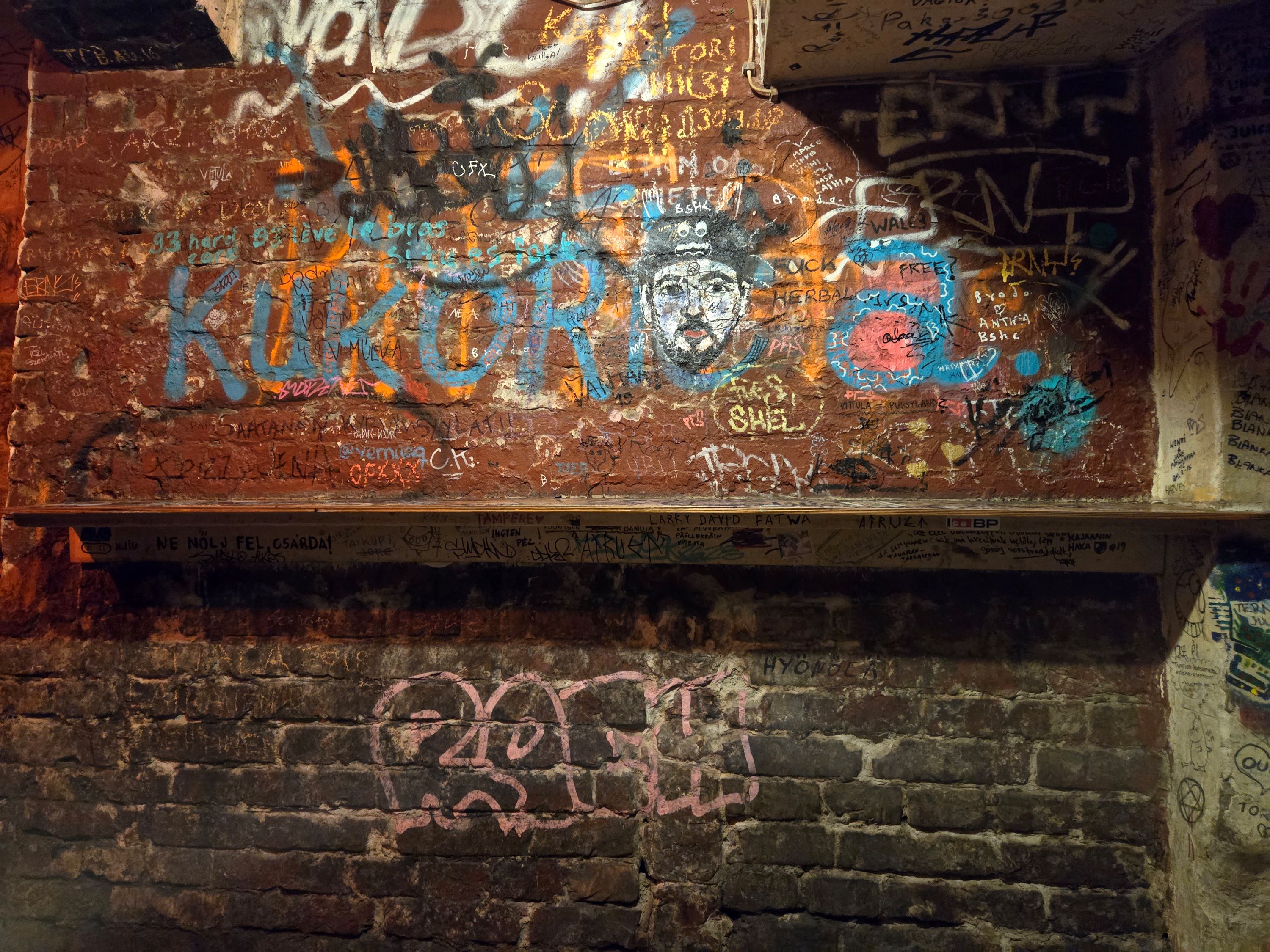
Another must-do thing in Budapest is to visit a ruin bar. Even if you don’t drink, you’ll want to see these famous underground bars that were once such an important part of Budapest subculture.
Ruin bars started out as bars in abandoned buildings primarily in the Jewish district of Budapest on the Pest side. They feature unique art, graffiti and sometimes things like plants or books.
The most famous and touristy ruin bar you can visit is Szimpla Kert. So many people recommended this bar to me before I visited. Every Hungarian I met, though, would say something to the effect of: “It’s interesting to see maybe, but very touristy.”
So I knew what to expect before going. It’s definitely interesting to see, but jam-packed with tourists of all ages. Some people seemed to just walk in, take a couple pictures and videos and leave. I’d say that’s about right for Szimpla Kert. This ruin bar is much more of an art museum or experiment than a bar in which you’ll want to spend a lot of time. It’s interesting to walk through all the different rooms and look at their art installations, but it’s not going to be the “true” ruin bar experience. And drinks are wildly expensive (for Budapest).
Instead of – or in addition to – Szimpla Kert, look for more lowkey ruin bars. Some people in Budapest will say there are no “true” ruin bars left, but you can at least find some decent facsimiles.
I enjoyed Lampas for a good ruin bar vibe. My favorite was a different ruin bar, but a Budapestian I met while visiting it told me it was a “secret bar” so I won’t name it.
Rub Some Statues for Good Luck
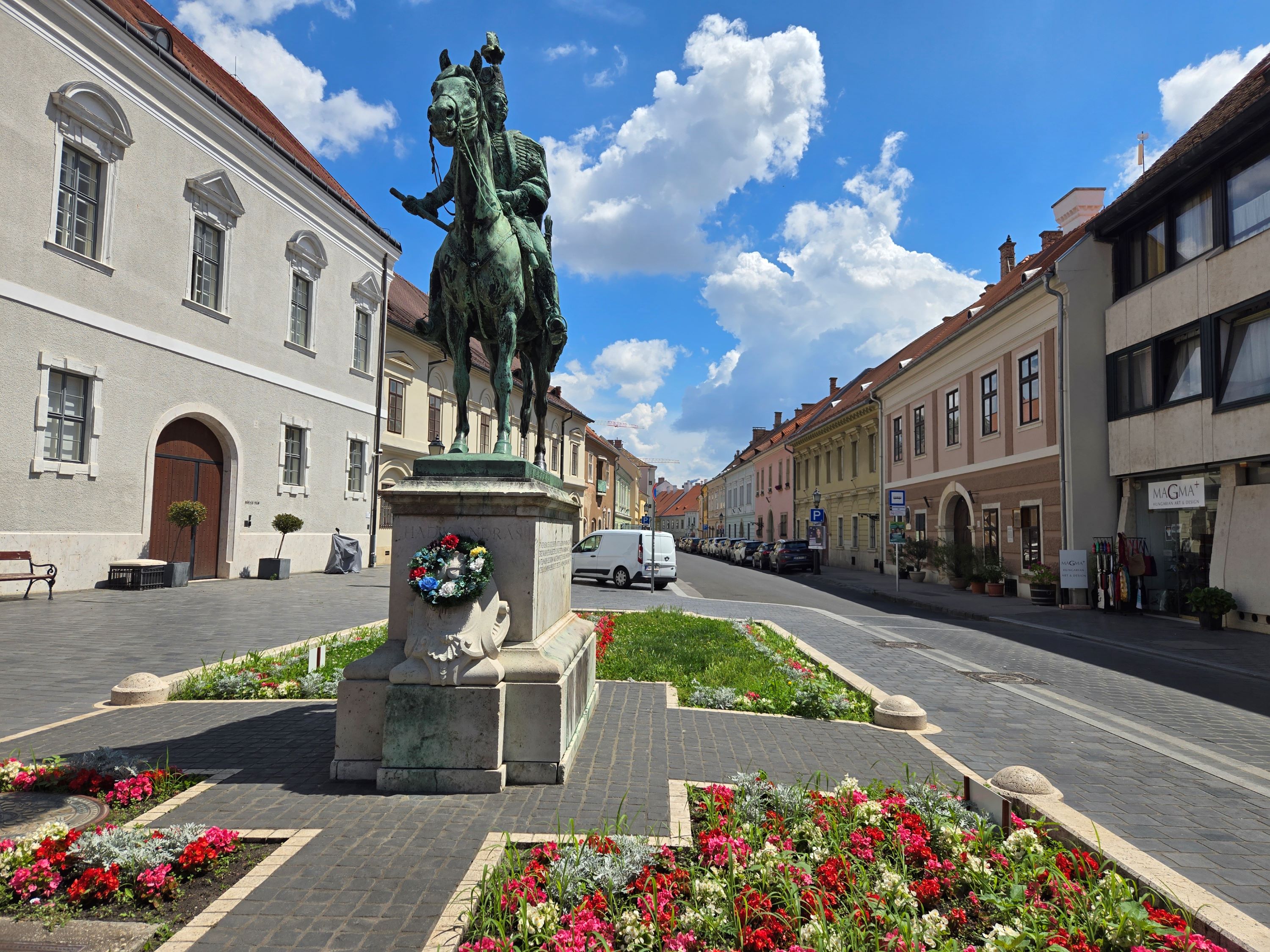
Budapest is home to a lot of different art and sculptures. They range from classical sculptures of kings and warriors to character statues from different comics and cartoons.
Some of these statues come with a little something extra, according to local legend. There are some statues throughout the city where legend says you’ll have different forms of good luck if you rub certain body parts.
Find the Fat Policeman sculpture on the Pest side, and you’ll notice his stomach is shinier than the rest of him. That’s because legend says that if you rub his stomach, you’ll be able to try all the different Hungarian dishes without getting sick or gaining weight.
Find the horse statue up on Castle Hill on the Buda side. You’ll find a certain part of the horse’s anatomy is also quite shiny. Legend says that students who rub this part of the horse will ace all their exams.
Visit the Ervin Szabo Library
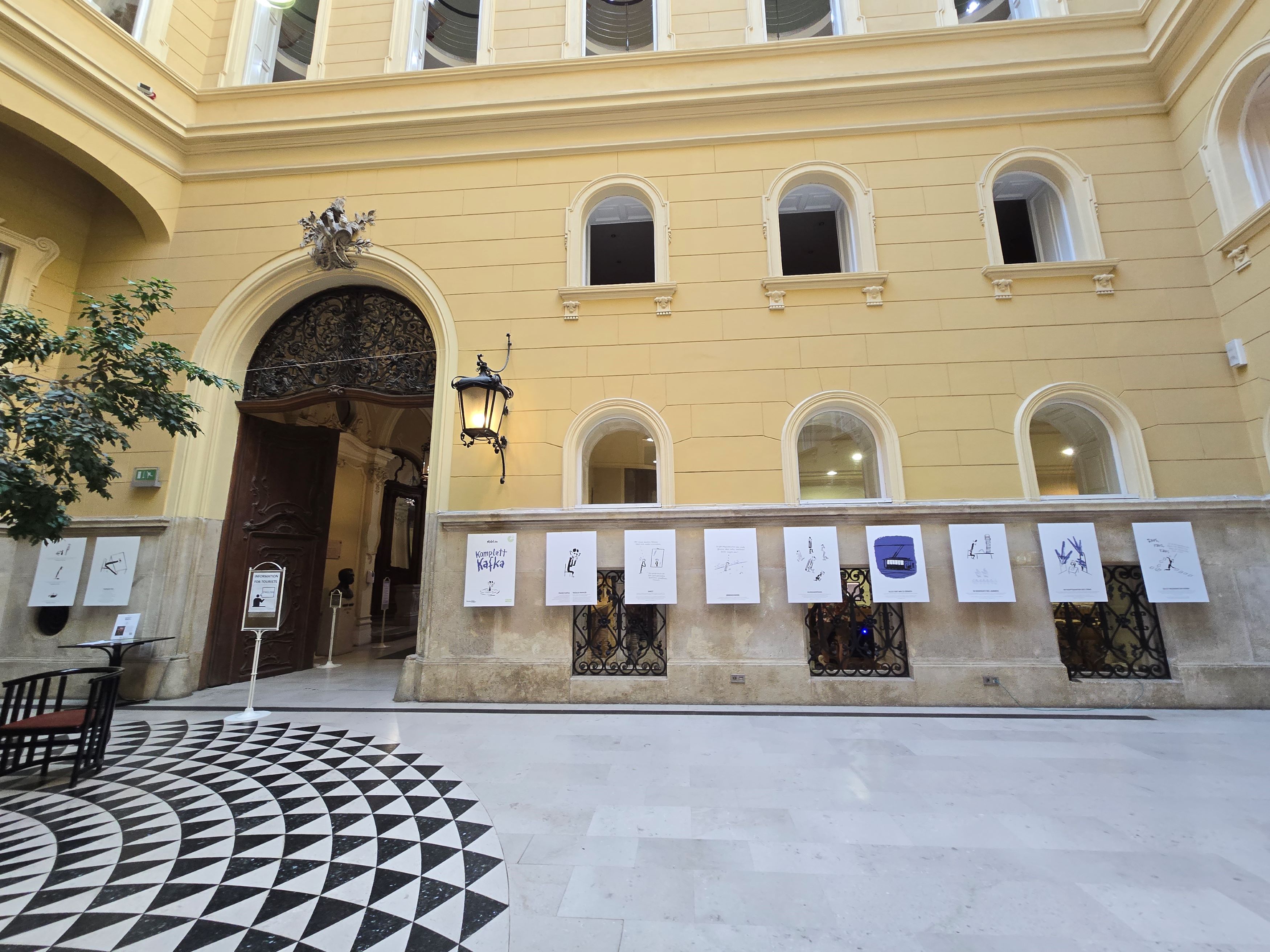
The main branch of Ervin Szabo Library is on the Pest side of Budapest. It’s also known as the Palace Library as it was originally a 19th-century palace built for Hungarian aristocrat Count Frigyes Wenckheim. It showcases the neo-baroque palace architecture of this time period.
Ordinarily, you can take a tour of this library to see the palace rooms and learn more about the history of this library. Unfortunately, the palace rooms were closed when I was in Budapest, but I was able to visit the building and see the front room of the library. It’s a beautiful building, and I can only imagine the palace rooms are stunning in real life.
Look for the Stumbling Blocks
Hungary’s stumbling blocks are a sort of Holocaust memorial you can find throughout the country. They are stones with primarily Jewish people’s names on them who were arrested during the Holocaust. Some of them are actually raised above the ground so that people might stumble on them when walking, but most that I saw were flush with the sidewalk.
These blocks sit in front of the original houses of Holocaust victims. The idea behind them is that people are only forgotten the last time their name is spoken, so these Hungarian Holocaust victims will be remembered forever.
The stumbling blocks have good intent behind them, but are a little controversial. Part of the controversy is for the raised blocks. If someone stumbles on them, they’re more likely to curse than to look down at the name in remembrance. The other part of the controversy is that people are stepping on the names of these Holocaust victims, which can seem disrespectful.
Regardless, they have an important meaning in Hungary. So keep an eye out for them if you’re in Budapest or other cities and villages in the country.
Visit the House of Terror Museum

The House of Terror Museum is one of the top things to do in Budapest if you enjoy learning about this kind of history. It’s in the former headquarters of the fascist Arrow Cross Party from 1944-1945. The museum claims to detail the horrors from the Nazi and Soviet occupation eras in Hungary, but primarily focuses on the Soviet occupation through 1956.
I think one of the most interesting elements of the museum is how it incorporates sound, light and even room temperature to help convey the mood and themes of different exhibits. Some rooms are small, dark and claustrophobic, while others are bright and loud but unsettling.
One of the most noticeable changes is when going through the prison cells where people were kept and tortured, it’s silent and stuffy – almost humid. Then, when you transition into the room that celebrates the post-1956 era when Soviet occupation became less oppressive, the air is cooler, and the room is brighter. You feel like you have space to breathe again, just as people in Hungary did after the 1956 semi-revolution.
Some people find the audio guide for this museum necessary.
I personally didn’t enjoy having one precisely because I feel like it took away from the overall sensory experience of the museum. Most of the signage is in Hungarian, but there are also sheets of paper in each room in English and a couple of other languages that summarize what the audio guide says.
I ended up turning off my audio guide for all exhibits except for the prison rooms where it was more necessary. However, my partner and our friend who visited with me both appreciated their audio guides. So I think it is really up to how you best learn information.
If you do visit the House of Terror Museum, be aware that there is also some controversy surrounding it. Some people think it paints Hungary as too much of a victim when the country was originally on the wrong side of history in the past. I think the museum is definitely worth visiting, but that is something to keep in mind as you tour it.
See the Shoes on the Danube Bank Memorial
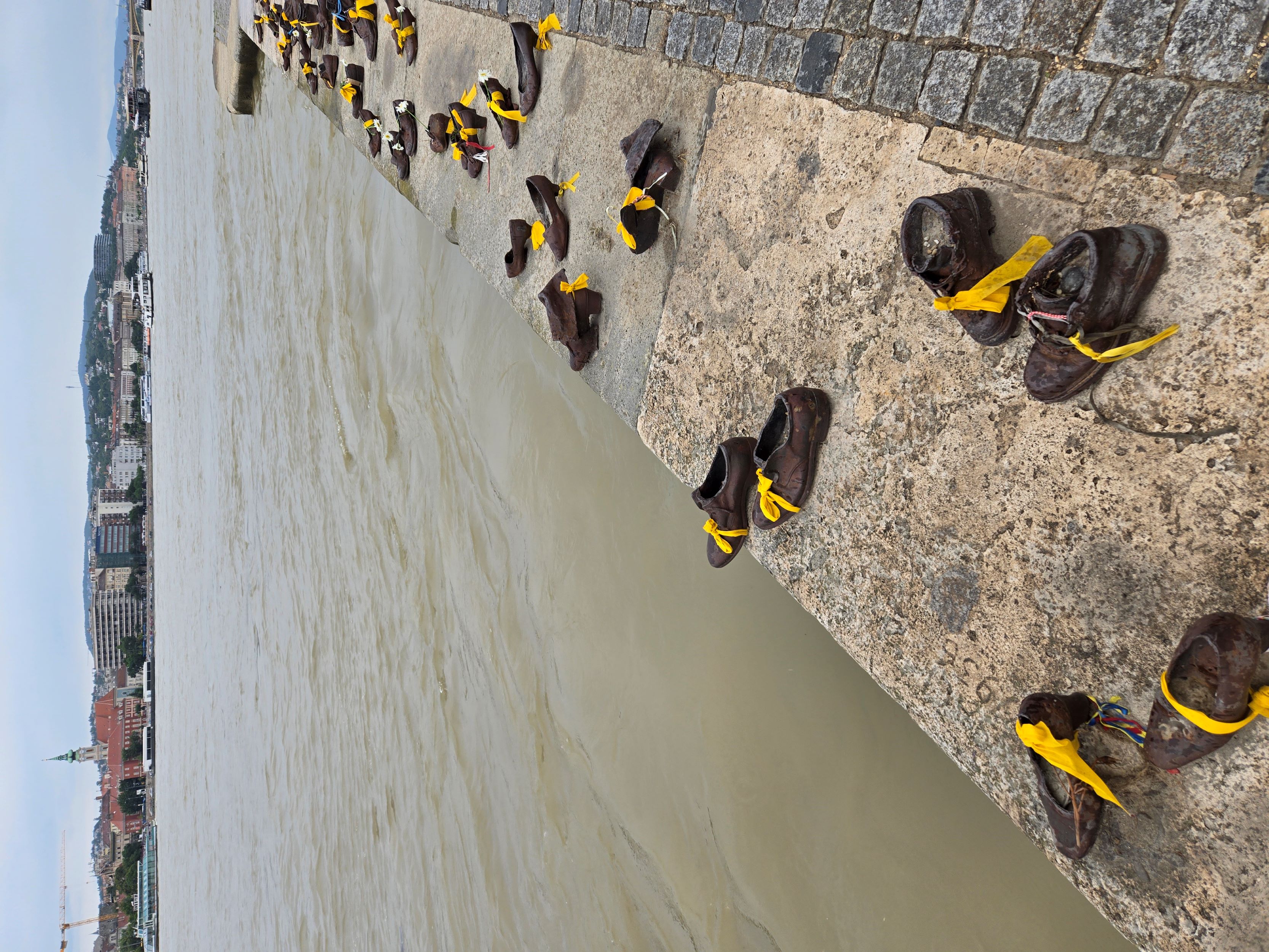
The Shoes on the Danube Bank Memorial is another Holocaust Memorial in Budapest. The memorial is a sculpture of several different pairs of shoes lining the riverbank.
This memorial commemorates Holocaust victims who were lined up and shot on the Danube river bank. They were lined up in such a way so that their bodies would fall into the river for easy cleanup. Often, their shoes would be the only things left behind of these victims as their bodies fell into the water.
The memorial is sombering, but an important part of Budapest’s past.
Admire St. Stephen’s Basilica
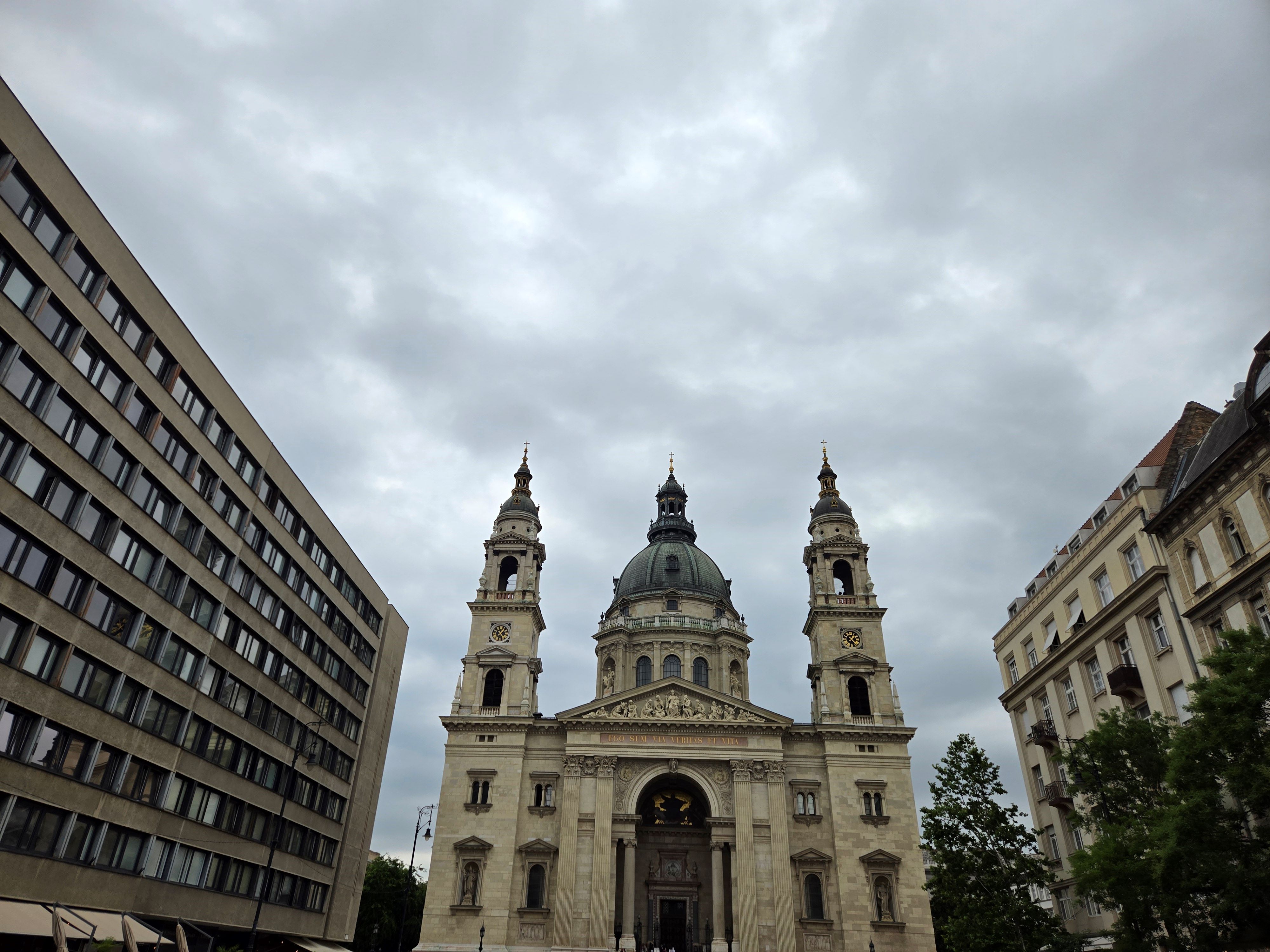
St. Stephen’s Basilica is a Roman Catholic basilica on the Pest side of Budapest. It was named for the first king of Hungary who is also credited with bringing Christianity to Hungary. The basilica is one of the most important and impressive buildings in Hungary. The dome is the same height as the Parliament building and shares the title with it of tallest buildings in Budapest.
During WWII, the basilica’s cellar helped keep war refugees and some of the Hungarian national archives safe, though much of the church was badly damaged and since restored. Both St. Stephen and the famous Hungarian footballer Ferenk Puskas are buried here as well.
I chose to admire the basilica from the outside. But if you pay to enter, you can visit the dome to see the art on the inside, including depictions of St. Stephen’s life.
Try the “Sandwich Shop with a Cult Following”
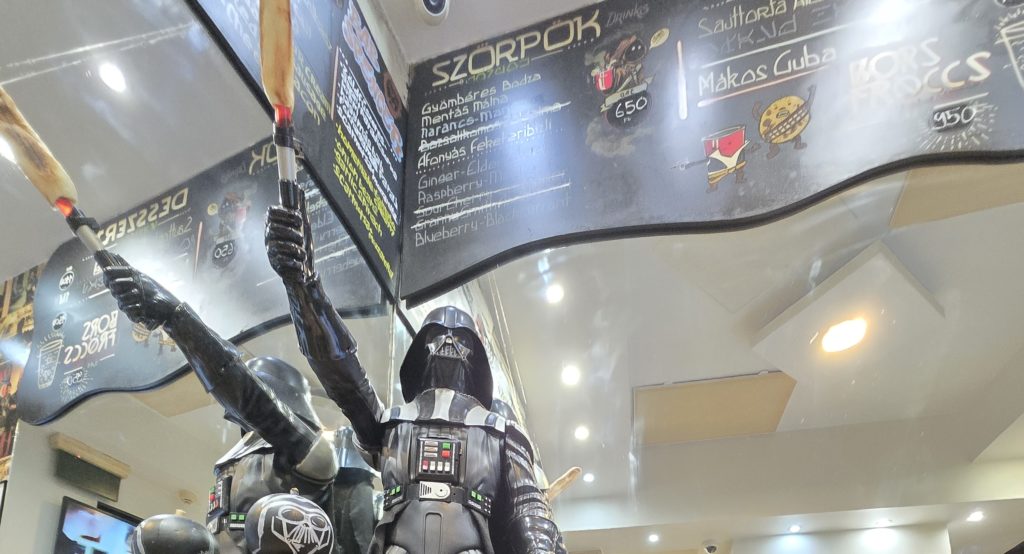
One of the most interesting restaurants I visited in Budapest was something I found on Reddit. The poster claimed it was a “sandwich shop with a cult following.” Calling it a restaurant is probably a stretch, because it seemed most people picked up sandwiches and soups for takeaway, but we chose to occupy three of the five available seats inside and eat our street food there.
Bors Gastro Pub makes simple but tasty sandwiches and soups at affordable prices. The sandwiches have different themes and typically include meat, cheese, sauce and potentially different types of vegetables or other spices. Their menu includes vegan and vegetarian options, plus a monthly rotating special. Bors also brews two types of beer – an IPA and a sour.
It’s popular to pick up Bors’ food for takeaway. But the interior of the restaurant is really fun because it is completely devoted to Star Wars. The walls feature Star Wars murals and mini character statues are on the counters. It’s definitely worth a meal here, even if you can only stop in to pick something up for takeaway.
Sample Different Hungarian Foods

I think Hungary is one of the best food destinations in Central Europe. Its foods are delicious, flavourful and diverse. And I didn’t even realize I needed Hungarian paprika in my life before visiting.
Here are a few of my favorite Hungarian foods in Budapest:
- Chicken Paprikash: One of my favorite new foods I’ve tried on this year-long trip is this dish inside a stew-like paprika sauce. One place for a delicious paprikash in Budapest is Rosenstein’s on the Pest side.
- Langos: This Hungarian street food is a fried bread that tastes kind of like a savory elephant’s ear (like from a state fair in the US). The most basic langos is fried and covered in garlic oil. It’s typically also eaten with sour cream and cheese as well, and some places include other toppings.
- Goulash: Hungarian goulash is similar to beef stew, and is typically served with bread or small noodle-like dumplings. It’s similar in consistency but has a different taste than Czech goulash.
- Kürtőskalács: Also known as a chimney cake, this popular dessert is a conical bread baked over fire and covered in sugar. It’s traditionally eaten as-is, but most tourist places also include ice cream or other sweets.
These foods are only a few delicious Hungarian dishes you can try. Remember to rub the Fat Policeman’s stomach so you can eat all of them without consequence!
Eat Hungarian Pastries
When we met up with our friend in Budapest, one of his requests was that we try Hungarian pastries in the morning – similar to what he does when traveling in Italy. Honestly, I was a little skeptical at first because I thought Hungary wasn’t really known for its pastries. But I was wrong! While Hungarian pastries are definitely not as famous as Italian pastries, there are plenty of country-specific pastries that are delicious and worth eating in the morning, afternoon and evening.
A few I liked:
- Pogácsa: This pastry dates back to the middle ages and has a consistency similar to a scone. The most popular types have pork cracklings (bacon) or cheese, but there are a few you can try.
- Strudel: Strudel dates back to the Ottoman empire and is an evolution of baklava. It’s a layered pastry with sweet or savory fillings. Some popular fillings include poppy or sour cherry.
- Torte: There are several different types of tortes in Hungary – a layered cake with different fillings, including cream and walnut. I recommend trying at least one of them in Budapest.
You can find these pastries in individual bakeries, metro stations and markets.
Drink Palinka
Palinka is a popular and important Hungarian brandy that dates back to the middle ages. It is the national spirit of Hungary and can be found all over Budapest. If you drink alcohol, you’ve got to try it at least once.
Palinka is made with fermented fruits. The most popular types of palinka you’re likely to find are plum and sour cherry. It’s not very sweet, but it is strong.
Additional Things to Do in Budapest
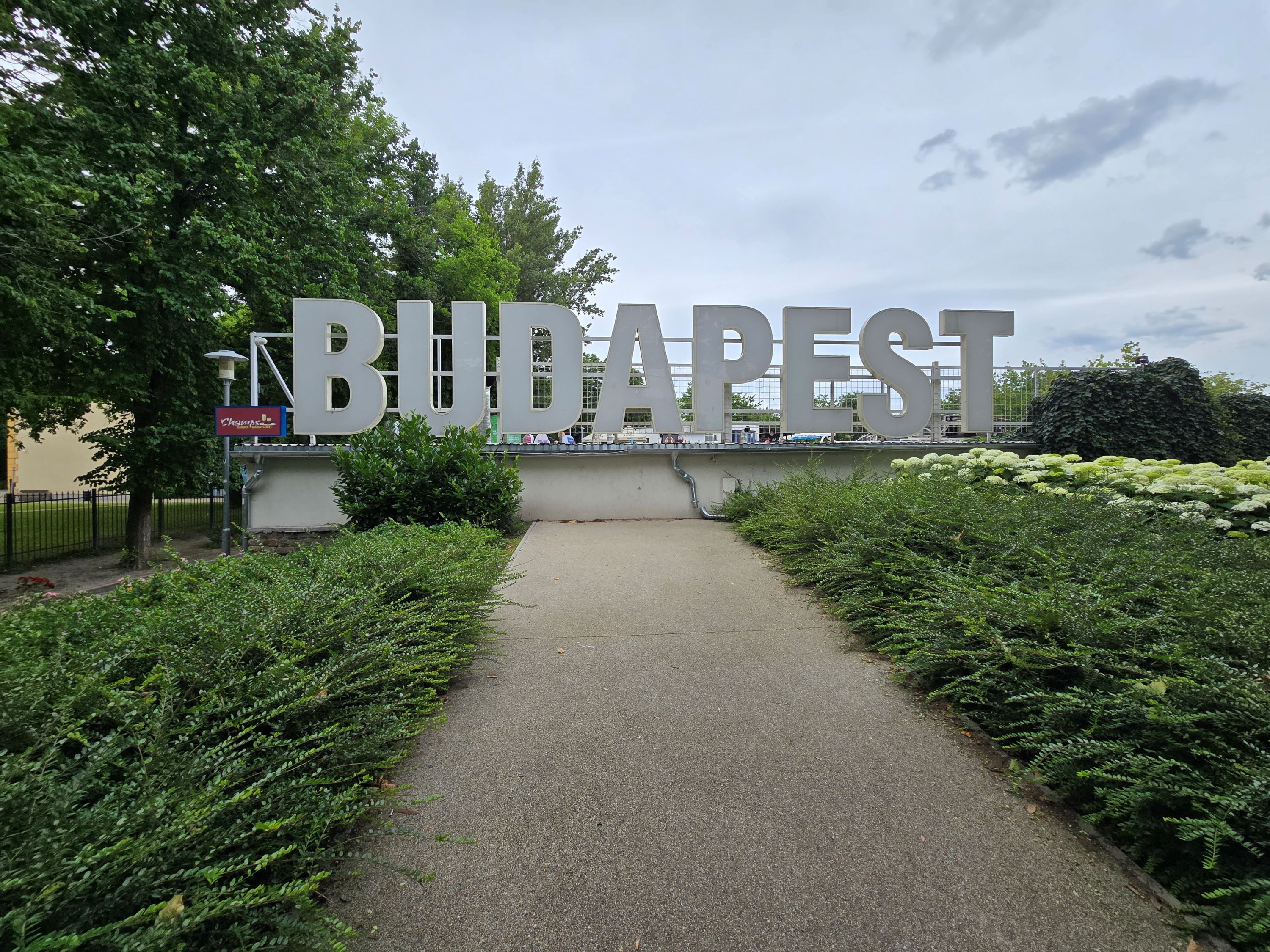
Budapest is a huge city. I really only scratched the surface of things to do in Budapest, and I could have spent at least one more day there. If you’re in the city for longer, or are looking for alternatives, here are some additional things to do in Budapest:
- Children’s Railway: A train run by children in the greater Budapest area.
- Koller Art Gallery: A private art gallery on Castle Hill.
- Labyrinth: The caves under Buda Castle.
- Vajdahunyad Castle: A castle in the middle of the City Park of Budapest.
- ELTE Fuveszkert botanical garden: Garden of tropical plants in the middle of the city/
- Zwack Unicum Museum: Museum about the Zwack family and the Unicum liqueur distillery.
- House of Houdini: Museum dedicated to the famous Hungarian magician.
- Heroes Square: Important square in Budapest featuring the Millenium Monument with the Seven Chieftains of the Magyars.
- Dohany Street Synagogue: The largest synagogue in Europe.
- Tower of Karakas Pasha: Turkish gardens and restored tower.
- Fisherman’s Bastion: Panoramic viewing terrace and UNESCO World Heritage Site in the Buda Castle Complex.
- Gellert Hill Cave: Cave church under Gellert Hill.
- Hungarian National Gallery: National art museum with a large collection of Hungarian art.
Budapest Logistics
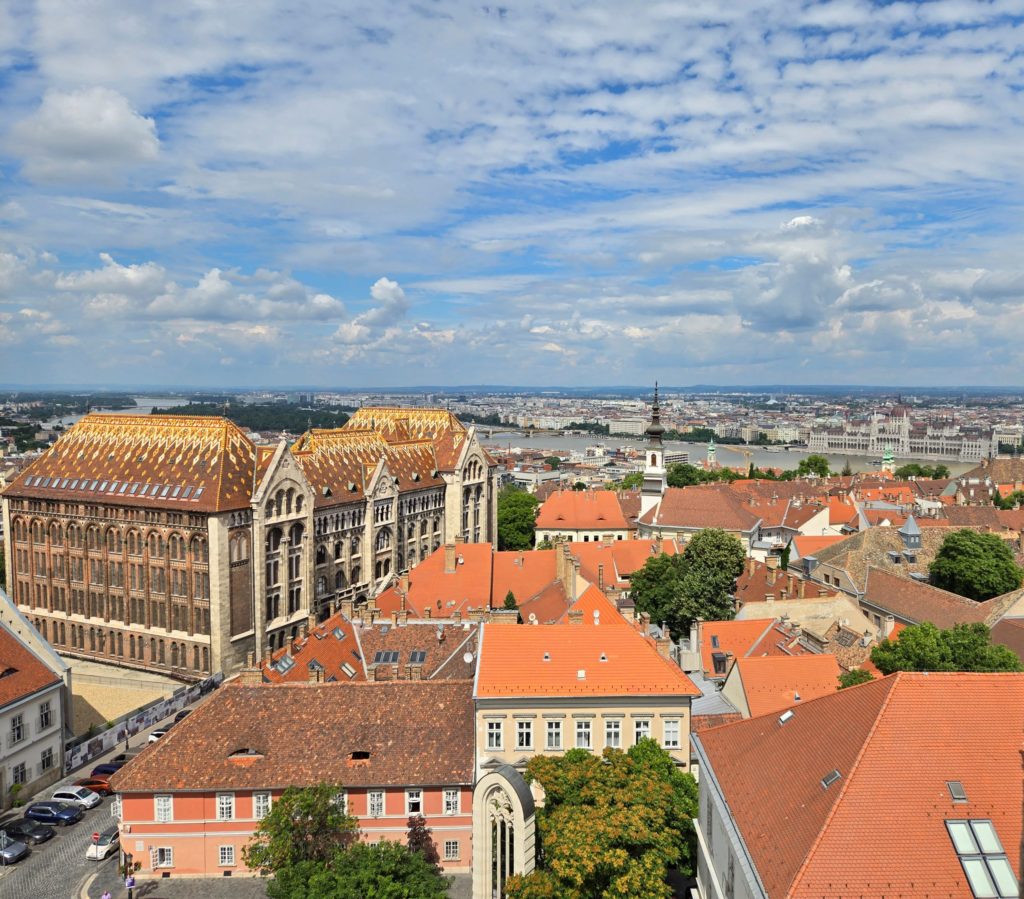
Where to Stay
As a tourist, you’re likely going to try to stay in one of the two main tourist areas on either the Buda or Pest side of the city. It’s easy to get from one side to the other, and there are pros and cons for staying in either.
- Buda side: The Buda side is considered the “nicer” of the two areas. It’s where most of the major tourist attractions are located.
- Pros: Close to main tourist attractions, usually quiet at night.
- Cons: Farther from the main bar and restaurants, a bit more expensive.
- Pest side: The Pest side is a good place to stay if you want to be close to better restaurants and bars.
- Pros: Closer to the most recommended restaurants and bars, generally more affordable.
- Cons: Noisier at night, farther from main tourist attractions.
I stayed in the Castle District on the Buda side, but I do wish I’d stayed on the Pest side. While it was nice to be so close to Castle Hill and some of the museums, I generally find it more convenient to stay close to the places I want to eat.
If you’re staying in Budapest for a longer period of time and don’t mind traveling a bit, staying farther out in the suburbs can be a good way to save money.
Getting Around:
Budapest has a lot of options to get around the city, and most are quite affordable.
Public Transit: By public transit, you can take the metro, tram or bus for about $1.25 per ticket. Metro is the easiest way to get between the Buda and Pest sides of the city.
Taxi: You can also travel by taxi. If you choose to do this, I recommend downloading the Bolt app to order rideshare taxis. It will ensure you’re getting a registered taxi and a fair price without having to haggle. All Bolt drivers should have their license visible in the car when you enter.
Walking: Walking is one of my favorite ways to explore a new city. Budapest was no different, but it is large enough that walking is not always the most efficient way to get around. If you’re on the Buda side, be aware that there are also hills and stairs.
Driving: Budapest drivers are a bit wild, so I recommend only driving if you’re confident in holding your own. And if you don’t mind the city traffic.
Safety
Budapest is considered a pretty safe city. I personally never felt unsafe while traveling there, but I was also traveling with two men. I’d recommend taking basic precautions in Budapest. Make sure you travel only in well-lit and populated areas at night. Keep your wallet out of your back pocket, especially in crowded areas. In general, stay aware of your surrounding.
Getting to Budapest by Train:
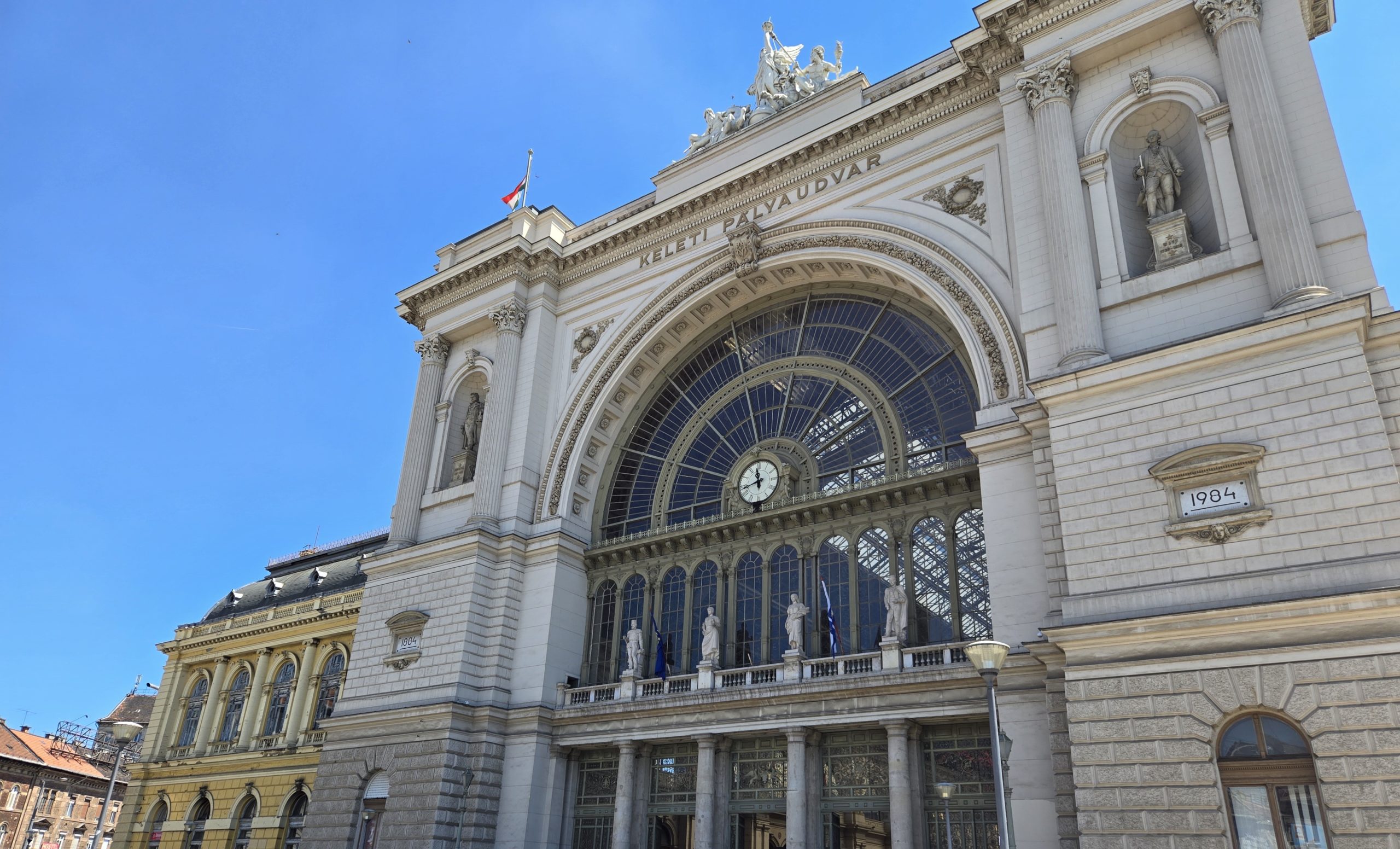
There are two main ways you’re going to arrive in Budapest – by plane and by train. If you’re visiting Budapest as part of a larger Central/Eastern Europe trip, I highly recommend arriving by train. It’s convenient, affordable and efficient.
I booked tickets to Budapest from Bratislava via Trainline, which is a convenient way to find and book train tickets in Europe. It can be especially helpful in Central/Eastern Europe as the train-specific websites aren’t always working well.
Honestly, I prefer trains to airplanes and buses when possible. It’s just a comfortable way to move around, and you don’t have to worry about showing up two or more hours ahead of time, or even packing your bags especially well.
Are you planning a trip to Hungary and need advice on things to do in Budapest or visiting in general? Feel free to reach out to me!
Pin this post to save it for later!

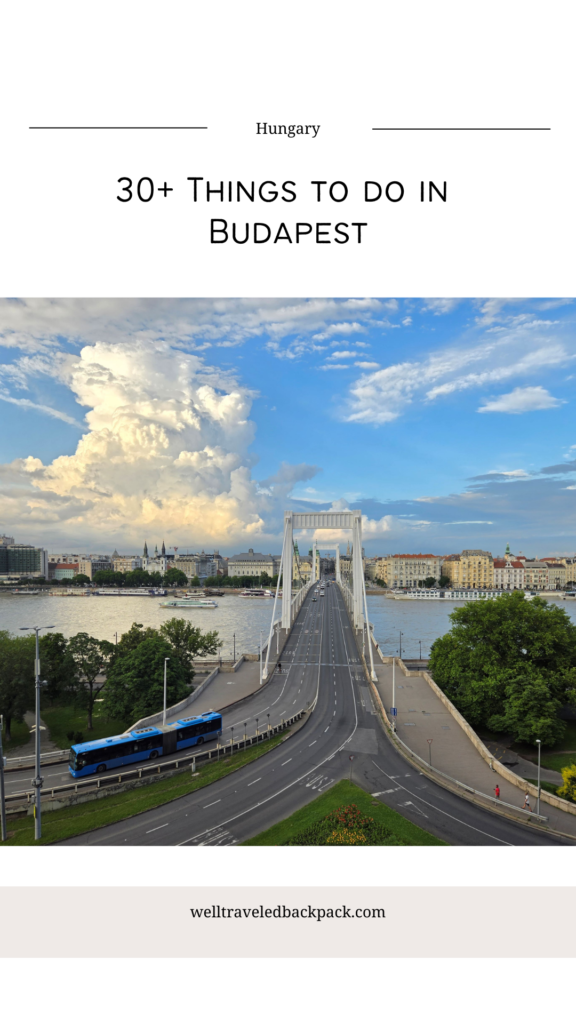

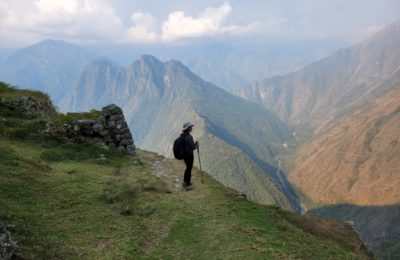
2 thoughts on “30+ Things to Do in Budapest, One of Europe’s Most Fascinating Capitals”